#edinburgh architects need
Text
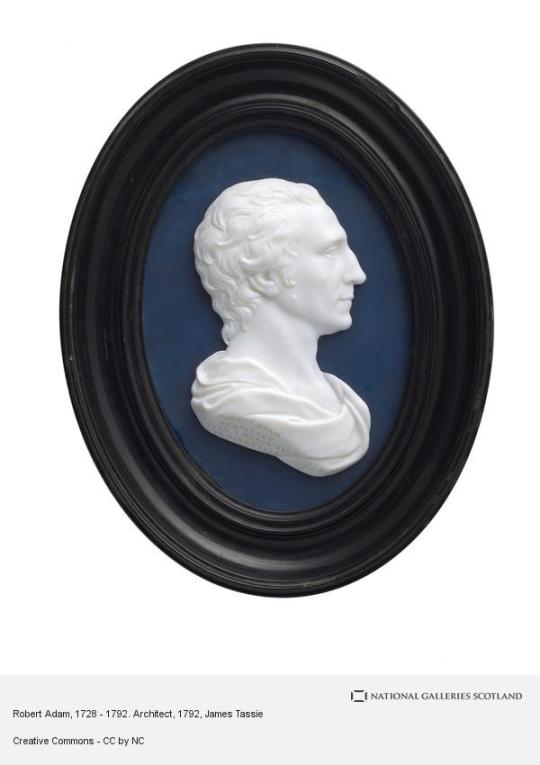



On July 3rd 1728 Robert Adam, the Scottish architect, furniture and interior designer, was born in Kircaldy
Robert Adam was the son of a Stonemason, William a stonemason who took up architecture, the family moved to Edinburgh when Robert was eleven, where his father had become the most popular architect in Scotland.
He attended The Royal High School in Edinburgh and was noted as having a "feeble constitution" His education continued at The University of Edinburgh where his studies were interrupted in 1745 due to wee bit of upheaval when the Jacobite Army of BPC arrived and occupied the City. Added to this he fell seriously ill at the end on the year and failed to graduate. On his recovery from illness in 1746, he joined his elder brother John as apprentice to his father. He assisted his father on projects such as the building of Inveraray Castle and the continuing extensions of Hopetoun House, his father died in 1748 and Robert and his brother ran the family firm now called Adam Brothers.
In 1750 Robert decided he needed to witness the architecture around Europe and departed on his "Grand Tour" in France and Italy. He studied widely the classical Roman ruins and increased his drawing skills.
On his return he opened his own architectural practice in London and soon became established as one of the most fashionable designers amongst the High Society. His Practice was timely as there was a renewed interest in England for all things Classical and the “Palladian Movement” (Based on the proportional architecture of the Italian Andrea Palladio) had just firmly taken hold. Adam was no slavish Palladian however and his Style has become known as “neoclassical”. He adapted and developed ancient styles rather than simply copying them.
As Adam was more often than not asked to renovate existing buildings much of his work was concerned with interiors. He was obsessive over every detail and designed everything himself down to plasterwork and fireplaces. He moved beyond Roman Style and was influenced by Greek, Byzantine and Italian Baroque design.
Adams work in Scotland include the Royal Exchange, in Edinburgh's High Street on the Royal Mile, The Royal Infirmary, Glasgow, Register House, Edinburgh and The Old College quadrangle at the University of Edinburgh.
In England he designed my favourite, Pulteney Bridge in Bath, as well as Kedleston Hall and Marlborough House, Brighton.
I think I have featured most of these buildings previously in posts so would like to showcase some of the meticulous interior work that Robert Adam was known for. As I've said before I am not a fan of the country houses, the places that reek of wealth, give me a ruined castle any day, but you have to admire the work that went into these interiors.
As seen in the first picture, Kenwood Library was added to Kenwood house in London by Adam between 1767-69 and you have to admit, it is beautiful as is The Marble Hall at Kedleston Hall, both these are open to visitors through English Heritage and National Trust respectively. Back in Scotland I couldn't finish this post without mentioning Red Drawing Dining room at Hopetoun House, made famous by the fictional Duke of Sandringham in TV Series Outlander.
13 notes
·
View notes
Text
The rolling English countryside faded into the distance behind us, giving way to higher, rocky crests. At last, eight hours after our departure from London, the city of Edinburgh rose up around us, and the train pulled into Waverly station, rousing Watson and I from our restless slumber. A fleeting caress coaxed me into full awareness, and I joined Watson in shuffling out of our cabin and off the train with the rest of our fellow passengers, dazed from the long journey.
What cobwebs lingered, clinging to the corners of my mind were quickly brushed away as I reflexively began to catalogue the men and women around us, picking up their luggage and ambling off to their destinations, paying each other little heed except as unexpected obstacles.
Inspector Lestrade found us in the throng, already bearing a telegram from the stationmaster. “The suspect, Mr. Marcus, won’t be leaving port for another day. Meanwhile, we’ve located whereabouts he’s staying.”
“Excellent, Inspector!” I declared. “It appears you will hardly be needing our assistance after all, but perhaps Watson and I will go and see his purported hideout in any case to see if we may find any further evidence which your men overlooked.”
I glanced at Watson and he gave an eager nod of assent, his eyes clear and bright despite the long, tiresome journey; what rest he had managed appeared to have served him well.
Lestrade gave us the address. We sent the porter on to the hotel with our luggage, and then Watson and I stepped out onto the streets of Edinburgh.
The sun had long since set on that December evening. The gas lamps flickering in the gloom were little different from our native London, illuminating the winding streets for the workmen and travellers still about despite the chill in the night air. Like them, we did not dally overlong, and as we went further from the station, into Old Town, the city grew quieter. Tall tenements lined the narrow, winding streets, nearly blocking the dark silhouettes of the hills from view. More recent edifices butted against mediaeval stone.
“Is that it?” Watson whispered, drawing even closer to me, his eyes flickering between mine and the tenement on the opposite side of the street.
“Yes,” I said into his ear, “that is the alleged spot. What do you make of it?”
“It has seen better days, but surely little can be gleaned of the inhabitants from out here?” His eyes again flitted up to mine with an incisive curiosity which has always had a remarkable effect upon my faculties, challenging me to reach a greater clarity of reason, if only that I might see his appreciative astonishment.
“The architects have been kind enough to leave us a few windows into the goings on within,” I remarked.
That earned me a reproachful look, but Watson’s curiosity easily won out, and he peered up at the tenement once more. “Do you know which window is his? Lestrade said he was on the second story.”
“By the number, I would guess the rightmost.”
Watson gave a gratifying gasp of astonishment. “The light is on, do you think he’s in there now? It’s a shame the curtains are drawn.”
“Worry not, my dear Watson.” I gave his arm a sympathetic pat. “We may be able to draw some inferences yet.”
#v writes#Sherlock Holmes#ACD Holmes#ACD Johnlock#H/W#John Watson#December Calendar Challenge of Awesomeness#prompt: a trip to Edinburgh#I guess it's convenient that I had them on a train last time (though I presumed they'd just be going back to London)
12 notes
·
View notes
Text
Whumptober 2022 - No. 27 - Magical exhaustion
Fili & Kili, T
The World Next Door: A Chrestomanci AU (Tumblr / Ao3)
--
Fili frowns at the powerwork covering his desk. It has been piling up for days, weeks—months if he is honest with himself.
A lot has been happening. The artificers are striking, and the streets are filled with unrest and dissatisfaction. The cost of basic necessities is rising on a nearly daily basis. And that has led to many more problems than he would normally face. This morning he had been called into a disagreement between a glass artificer and his employer. He had not needed to use magic to solve this problem, but he did have to sit and mediate the disagreement. Both parties had been unsatisfied with the resolution, but it was done, and Fili’s morning had been eaten up by what should have been a minor dispute.
It is good that he did not need to use any magic.
Fili is not sure if he would be able to conjure even so much as a flame to light a candle. And his confidence in being able to perform basic tasks has been diminishing as he is drained of nearly everything he has.
He has been spending most of his days in the fields, along with any other magic user who is capable of doing anything with water or rain, far south of Edinburgh. This is the odd day that he is actually home after a four hour train ride north. He just wants to sleep, but this pile of paperwork is taunting him.
The Minister wants reports on how much water has been “summoned” so far. He wants detailed accounts of everybody who has assisted in the efforts. He needs data. He needs morale reports. He needs harvest projections.
And Fili just cannot.
He runs his hands through his hair. And just stares at the precarious beige piles.
If he does nothing they will simply continue to grow. And he will still have to deal with them in the very near future. And if he waits then the Minister will likely visit and demand, well, not demand, he would be more polite, but he would certainly imply that Fili is incapable of doing the job that he has been given.
When Fili would try to explain the present situation and how he is far, far busier than he has ever been before the Minister will tell him that he is “sorry” in a highly disingenuous tone. Then the Minister will leave and Fili will be expected to stay awake for as long as necessary to finish the work. But Fili knows that the reports and memoranda will not be touched for months, or years, if they are ever touched at all.
Thorin knocks on the door frame. “Can I get you anything?”
“A second me,” Fili groans.
“Not really possible.”
“I know. I just really, really need to sleep, but there’s this,” he gestures to the desk.
“Leave it.”
“Says the man who never let me go to bed if my homework was not finished.”
“That’s different. Homework is meant to help you learn something, this,” Thorin waves at the piles dismissively, “is just a waste of paper. I know it. You know it. The Minister and all his employees definitely know it. It is only useful to the architects and workers who have to design and build the giant buildings meant to house all of these files.
“Go to bed.”
Fili pushs himself to his feet; he wobbles.
“Should I have Ciri draw a bath?”
Fili shakes his head. “If I tried to take a bath right now, I would probably fall asleep and then drown. And that would be such a waste of a life.”
“Goodnight then.”
“Goodnight.”
Fili falls into his bed fully clothed. The effort needed for him to get rid of shoes, socks, belt, and clothes is beyond him. He grabs a blanket and pulls it over his body. He ache to his very bones. He has spent days pulling water up from lower levels of the earth to provide water to the browning and dying crops. He has been pulling water up the canals from the lakes further south and those closer to the sea. And the thought of summoning up anything else, for performing any small magic, is painful.
It takes him forever to relax enough to even be close to sleep. His muscles twitch and his mind races. Because what happens if he cannot do anything when he goes back in a few days, what if this drought does not end, what if… what if…. What…
Fili squeeze his eyes shut. He cannot stand to look at the green velvet canopy of his bed any longer.
“Sleep,” he commands his body. He starts to think of each muscle in his body relaxing them and slowing his breath.
But instead of sleep he feels the pull in his chest.
“No…” he groans.
His only preparation is the twisting darkness. He lands on his feet in a dark alleyway. It is misty and damp. He shivers. His overcoat is hanging in his closet in an entirely different world.
“Chrestomanci?”
Fili turns and sways on his feet. He squints. “Kili?”
Kili nods.
Only a year or so has passed in Fili’s world since he first met Kili, but more time has passed in Kili’s. Kili is older with a shadow of beard fluff on his chin. Fili has only seen Kili twice since that first time. But he has developed a fondness for the tenacious boy who often acts without thinking. But without that lack of forethought Fili would never have met Kili in the first place, so he cannot begrudge it too much.
Fili closes his eyes to force his brain into action. “What… Why am I here?”
“Come on.” Kili grabs Fili’s jacket sleeve and tugs him further into the alley. “The Govenors won’t do anything.”
“About what?” Fili straightens his rumbled clothes. He feels uncomfortably exposed. His exhaustion and the unexpectedness of the call has dropped his normally omnipresent professional facade.
Kili glances down the alley to the well-lit main street.
“Before that—Where are we?”
“Cambridge. I’m reading History of Magic here.”
Fili nods. “So those would be the school Governors that you are talking about.”
“Yes. And they won’t listen to me!”
Fili rubs his face roughly, trying to wake up and process information faster. “What is it that you’re telling them?”
Kili looks around hesitantly, looking for eavesdropping ears. “Some of the professors have been practising blood magic.”
Fili’s attention sharpens just a little, “How do you know this?”
“I went to get some tutoring after one of my readings and my professor’s door was open. He was in there talking with another faculty member,” Kili’s voice drops into a lower register. “They were talking about where they could get more people to drain for blood.
“I thought maybe I had misheard so I didn’t say anything. I just went to my tutoring but then I saw the other professor talking to one of the less fortunate students—those that don’t have any place to stay—and then she was gone a few days later. And that happened a few more times.”
“How do you know that the student’s didn’t just go home? Blood magic is a serious crime.”
“I know,” Kili says, exasperated. “One of the students was a friend of mine. One day he was in lecture like normal. We ate in the dining hall together. And then he was gone. I even took the train into London to see if he had gone home or had been sent down, but his mother hadn’t heard from him.”
“People disappear for all kinds of reasons. Do you have any proof that these professors are doing what you allege they’re doing?”
“I wouldn’t have gone to the governors if I didn’t!”
“And they didn’t believe you?”
“No. The two professors are tenured and published, so they bring in a lot of donations and students.”
“What sort of proof did you have?”
“I can show you.”
“Lead the way.”
Kili uses only the narrow alleyways that run between tall buildings that block out whatever dim light could have been provided by the night sky. The mist gets more dense, thicker, with patches of clear air becoming more rare as they walk.
“I followed them,” Kili explains, fingers trailing on the rough stone walls. “One night.”
Fili bit his tongue to stop a rebuke.
“Don’t worry,” Kili says, responding to Fili’s unspoken admonishment. “I do have a specialty beyond the most basic of spells. I’m an Ófrisi.” The note of pride in his voice is unmistakable. “So they didn’t even know that I was following them.”
Fili frowns as he tries to recall the different names and descriptions given to similar abilities across the worlds, but Kili beats him to it.
“I can tell when someone has passed close to an object for a while after they’ve passed it. Stone remembers better than wood, and most of Cambridge is stone, so it was easy.”
“Is that what you’re doing right now?” Fili asks, looking at Kili's slender fingers on the damp stone that was slick with moss in many places.
Kili nods. “It’s been a while, but they did come this way. I can’t tell which direction they were going though…” He trails off. “Usually I can tell because it will get stronger or weaker as we go. But… It’s not working?”
“Don’t they meet in a usual spot?”
Kili shakes his head. “No. Probably to avoid getting caught.”
Fili nearly runs into Kili when he stops suddenly.
“I think this is where they are,” Kili says in a hushed tone. “But, I don’t see…” He steps back to look at the tall, blank walls of the brick building.
They circle the building looking for an entrance. There is a row of shop fronts facing that larger road, but even if Professors Dudek and Harmin had used those, they are not an ideal option for Fili and Kili.
The mist turns into a light rain that quickly soaks through Fili’s woollen jacket.
“Are you sure they’re here?”
Kili stares at the building with hands on his slim hips. “Pretty sure.”
“Let me try something.” Fili gently lays both hands on the stone. He closes his eyes. Normally this task is easy, something that he does with half of a thought. But this feels like the first time all over again. Eyes closed to shut out any extra information, fingernails catching on the rusticated stone, deep breath—”
“Maybe—”
“Be quiet!” Fili snaps.
“Sorry.”
Fili can hear the hurt in Kili’s voice, can see the shuffle of feet and the slump of his shoulders without looking. He will apologise later.
A deep breath, he squeezes his eyes shut in effort, then he feels his consciousness expanding, slowly, in fits of starts and stops. And then it stops. He cannot press it any further. He tenses, his finger curling and pressing into the stone as he tries to force it. But it will not go any further.
Fili steps back from the wall. He sways and catches himself. “There is no hidden door on this side. We will have to check the other sides individually.”
Kili nods wordlessly and makes for the back of the building and its alleyway filled with overflowing trash cans and deep puddles.
“Kili,” Fili catches Kili’s sleeve. “I’m sorry. I just need to concentrate and I—”
“And I talk too much.” Kili’s face breaks into a lopsided grin. “Don’t worry, I’ve always been told that. I was once banned from raising my hand more than twice a lecture.”
“I really am sorry about my tone,” Fili presses. “Magic is just harder for me at the moment.”
“Is it that weakness you told me about?”
“No. And don’t think I’m going to tell you what it is. That’s private.”
“And here I was thinking that we were friends,” Kili says with a mock hurt on his face.
“Come on.”
They round the corner into the back alley. The wall is too big for Fili to do in one go.
This time it is even harder. His muscles start to tremble almost immediately and he feels very lightheaded. “Nothing,” he says with a gasp, stumbling away from the wall.
Kili’s eyes sharpen with concern. He catches Fili’s arm. “What’s wrong?”
Fili flaps his hand dismissively. “Nothing.”
Kili’s face darkens and his eyebrows furrow, but he does not argue.
The rain picks up. Ripples spread through the puddles. Rain drips from the gutters, each drop fatter and more irritating than a regular raindrop. They are both soaked. Fili imagines a warm bath and his bed as he makes his way deeper into the alley. He needs to use the wall to support himself. He will not be leaving his bed tomorrow, he promises himself, no one will be able to make him.
He swears when he steps in a particularly deep puddle. His entire foot and low boot are immediately submerged, and now his boot is filled with water that squelches with each step. “Just great.” He can feel Kili’s eyes on him. He wants to snap and tell the boy to stop staring at him, but he does not. It is only years of training that makes him hold his tongue. His facade of professionalism may be slipping, but it is not entirely gone in his exhaustion.
The stone here is slick with mould that will leave green smears on Fili’s fingers and trousers when he wipes his hands on them. He takes a deep breath. His muscles start shaking before he even starts this time. He grits his teeth, they crack against each other, he will not have the strength to do this again.
But there it is. A flicker on the far corner of the building. The bricks seem to shimmer and shift like a lake in a strong breeze.
“There,” Fili says, pointing. He manages to hold it long enough for Kili to see the spot as well. But he does not release the magic, it snaps back into him with a jolt like a snapped rubber band. He groans as the shock of it reverberates through each and every bone in his body, even his toes and teeth ache.
Kili reaches the hidden door long before Fili does. He already has it unlocked and is stowing away a set of slender tools. He shrugs when he sees Fili’s curious glance. “Sometimes magic isn’t the best or only answer. Magic-users tend to forget that there are non-magic means of making things happen.”
Fili knows some government administrators back home who could learn from that simple statement.
The door opens surprisingly quietly. There is no light, just darkness. But it is dry. Kili starts to enter it, but Fili stops him. “Let me go first.”
Doubt flashes across Kili’s face.
“I still have 7 lives. You only have one.”
Kili exhaled heavily through his nose. “Fine.”
“You say that like you have a choice.” Another crack in his professionalism.
Kili follows Fili down the dark hall that only gets darker as they get further from the door.
“It’s stronger here,” Kili whispers.
Fili nods sharply. There is something wrong here. He can feel it twisting and dark in the very air that they are breathing.
When they reach a split, “Left.”
Then there are stairs. At the bottom there is a shut door and there is a faint flickering light within.
Fili takes a deep breath. He still cannot feel any flicker of power. “This is such a bad idea. We should come back at another time.
“But what if there are innocents?”
That final thought pushes Fili forward.
The iron of the door handle is ice cold. He yanks his hand away.
Fili presses close to the door. There are voices on the other side, but they are muffled and indistinct, clearly far from the door. He pulls his jacket sleeve down to cover his palm. The handle moves, but the door does not open.
“Locked,” he whispers.
Kili shoulders his way in front of Fili. He fishes out his tools and drops into a crouch. He hisses when the cold iron burns his skin. After that he is careful not to touch the handle as he inserts the tools and turns them slowly, listening and feeling for the telltale click and catch.
This door creaks when it swings open. They both stay there, frozen, and waiting.
Kili tries to go first, but Fili stops him.
On the other side of the door is a long hallway with rooms on either side. The light is coming from a room much further down the hall. The feeling of wrong is more powerful here. It smells of damp, mould, and the warm, sickening scent of decay.
Fili gestures to the openings into dark rooms. “Check those,” he whispers, barely louder than a breath. “If there’s anyone being kept there, get them out.”
Kili scowls. “What about you?”
“I’m Chrestomanci.”
Kili snorts and starts checking rooms.
Fili does his own checking. But he moves quickly. The room at the end of the hall is beckoning him. That is where this is all coming from.
The professors might change locations, but they clearly rotate between several chosen locations, because this is not the first time that this basement has been tainted.
Finally he is close enough that he can see into the room. Two men in black robes work with quick surety in the dimly lit room. But even with the lack of light Fili can see that there are people stretched out on tables. The smell of blood and decay is much stronger here. Fili tries to force his brain to comprehend what exactly he is seeing. It is clearly not anything good, but he looks for evidence of blood magic.
There is a flash of flame, and a metallic smell of hot blood.
“Anything?” One of the professors asks.
“No. I think we need more,” replies the one leaning over a table covered with notes.
“We’re running out of subjects.”
“Then we’ll find more.”
“People are starting to get suspicious.”
“Then we’ll go to London.”
Both men look up when there is a shout. Fili instinctively presses himself to the wall to avoid being seen. Not how he would normally react. He knows that he should step into the light and calmly ask the men what they are doing. And he will. In a moment. When his brain is less fogged. And when his magic has another minute to recoup as much as it can.
“This bastard was trying to free the other subjects,” a third voice snarls.
Fili looks back into the room. There had only been two men before, but now there is a third. There must be another door into the room that Fili cannot see.
“Killian?” One of the professors says, confused.
“Fuck,” Fili mutters to himself. He should have stayed back, helped check those rooms.
Fili steps into the light then.
“What is the meaning of this?” he asks imperiously, facade firmly back in place.
The two professors look away from the third man—Fili can now see Kili on the ground between the professors and the large man, unharmed—and to Fili.
“And who are you?”
“I am Chrestomanci.”
The flash of panic on their faces gives Fili a flash of power. “That student is helping me, so if you would kindly release him I would be grateful.”
One of the professors moves quickly, there is a flash of metal.
“No!” Fili shouts. Every particle of magic left in his body sparks and fills his hands. The concussive force that explodes knocks him to his knees. He does not need to see the professors and their accomplice to know that they nearly gone. He can already feel a lightening of the room. But then one of those flickers back, stronger.
At least one of them is not gone.
And there’s Kili.
Safe.
Fili sways and then everything crashes into darkness.
—
“Come on,” Kili hisses. He has Fili by his jacket and is trying to haul him to his feet. “The guard will have heard that.”
“I’m Chrestomanci,” Fili says blearily. “They were breaking Intermonde law.”
“Yeah. I don’t know if they’ll agree with that. The university is a country unto itself, and you might not remember, but my world isn’t too fond of people from other worlds meddling in our affairs.”
“My job…”
“I know. Come on.” This time Kili is able to get Fili to his feet.
“The people…?”
“Gone. Well, those that were still alive. I had them leave already.”
“Good.”
They move slowly with Kili staggering under Fili’s weight.
“Where are we going?”
“My rooms,” Kili grunts.
“But—”
“Only my bedder is ever there. And I can keep him away if need be.”
“You’ll be reported…”
“By Marvin? Maybe, but unlikely.”
“No, Dudek and—”
Kili shakes his head. “I don’t think they’ll risk sending me down, because I can just tell people what we saw. And even if I don’t have proof the newspapers will probably pick it up because it’s a great story and the university would hate the bad press. No, I’ll just avoid having lectures or readings with them…” then more quietly, “I might have to change colleges though to do that.”
“I’m sorry,” Fili slurs. His feet keep dragging despite his best efforts to support himself.
“No. I’m the busybody who couldn’t leave well enough alone.”
“But it wasn’t well enough. People were being hurt and you wanted to stop it. And we did save those who were there tonight.”
“Three people,” Kili says bitterly, “but what about the people that come after them? Harmin and Dudek will just find a better hiding place.”
“Sometimes the good we do ripples out and has unseen consequences,” Fili quotes the previous Chrestomanci.
Kili’s short laugh is bitter. “I guess I’d just like to see it.”
“Wouldn’t we all,” Fili mutters.
They manage the rest of the way in silence. Kili takes them to a back entrance on the river path into his college. Kili’s rooms are off a small courtyard with only two staircases.
“Just sit there,” Kili says, depositing Fili onto his bed. The armchair and the desk chair are covered with discarded clothes and haphazard stacks of books.
Like Fili has a choice. He plants his hands on the edge of the mattress to keep himself upright. He stares at his feet that are leaving expanding puddles on the ornate rug that covers the stone floor of Kili’s room.
“Take your clothes off,” Kili orders without looking at Fili.
Fili looks up to see Kili rummaging in his wardrobe. “What?”
“You’re soaked. I don’t know if I have anything that will fit you. But even just a dry blanket will be better than wet clothes.”
It is then that Fili realises that he has not gone back. He should have gone back. He should be dripping on his own floor, getting dry clothes from his wardrobe. But he is not. He is still here with Kili. But it was over. Returning has always been automatic before, sometimes being yanked away before he thought he was done. He has never even had to think about it. Now he closes his eyes and imagines that twisting yank in his chest.
Nothing.
“Off,” Kili orders officiously, tugging on the cuff of Fili’s jacket.
Fili opens his eyes. Kili is standing there with dry clothes slung over a bare shoulder.
Bare shoulders.
Fili forces himself to focus. Kili’s hair is ruffled and wild from a vigorous towelling, his chest is dry, his feet are bare, but his pants are still dark and dripping.
“Off.”
With Kili’s help Fili sheds the jacket that, swollen with water, is tighter on his arms and shoulders than it should be. Then the vest, the tie, the shirt, the undershirt.
Kili then uses the already damp towel on Fili.
Then his soaked low boots and stockings join the pile of wet things in front of the ticking and clanging radiator.
“Trousers.”
Fili takes Kili’s hand and rises to his feet with considerable effort. Kili fixes his gaze on the window behind Fili to grant him a modicum of privacy while Fili struggles to unfasten his belt and pants with one hand. He has his other hand firmly planted on Kili’s shoulder, which is thicker and sturdier than he had expected. The wet wool is difficult to remove, it just bunches and clings, but Fili eventually steps out of his trousers and pants.
“Here.” Gaze still fixed on the dark window Kili pulls a pair of blue and white striped pyjama bottoms from the pile on his shoulder.
Fili looks at the bottoms and then at his feet. “I need to sit down for this.”
Kili nods.
The spot where he had been sitting is damp and cool; Fili winces when it touches his bare skin. He bends over to insert his feet into the legs of the pants and slowly works them up his legs and over his hips. The pants are too long and tight through the hips, but they are dry.
Only then does Kili break his staring contest with the window. “I’ve got some socks, a shirt, and a cardigan as well,” he says, laying the items out on the bed beside Fili.
Fili nods. All of his attention is focused on putting his limbs and head through the correct holes. He does register the sounds of Kili searching for more dry clothes in his wardrobe. Fili looks up at one point to see the pale expanse of Kili’s back and buttocks that are demarcated by a line where the pale skin meets even paler skin.
Fili flushes and instead of looking focuses on threading the toggles through the rope catches on the cardigan. “Professionalism,” he reminds himself.
Once dressed Kili grabs a pillow from the bed and drops it on the floor followed by a blanket.
“What are you doing?”
“Making up a bed.”
Fili starts to rise.
“No,” Kili plants a hand on Fili’s chest and pushes him back. “You’re taking the bed.”
“But…”
“You saved my life. You get the bed,” Kili says firmly. “Besides, you outrank me.”
Fili snorts in disagreement. “There’s plenty of room up here. We can share.”
Kili does not move at first, thinking about what Fili said. “If you insist.”
There is very little room to spare in the narrow bed. But here Fili falls asleep almost instantly even with the clang of the radiator, the creaking of the bed frame and springs, Kili’s breathing, and his worries about what happens if he is still unable to do any magic in the morning.
#whumptober2022#no. 27#magical exhaustion#the hobbit#fic#bb writes#fili & kili#fili/kili#fiki#chrestomanci au
9 notes
·
View notes
Text
220824 • 3:54pm 📷
Modernism in Edinburgh, part 5.
These are from a walk I took on day 1 to get to know the area, doing some convenient building spotting along the way.

Up first is the remains of the old St Cuthbert’s Cooperative. Nothing too remarkable in the current state, but it does catch your eye as a change of pace in the long line of elaborate stonework.

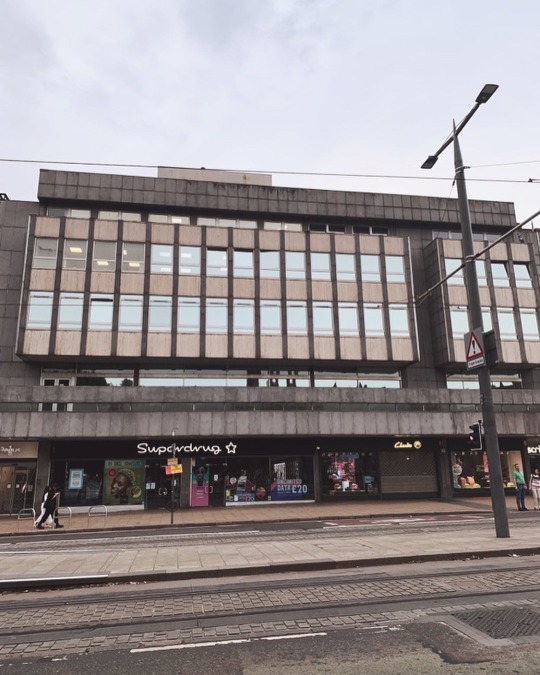
With a bit of a detour, we get over to Princes Street on the edge of New Town. (I thought it was like Edinburgh’s Oxford Street - complete with the cursed American Candy stores. When will they stop?) There is the New Club spanning across a good bit of the street, but I did not figure out how to get inside (apart from the ground floor shops). I was told that the interiors had some delightful concrete + tartan, but wow, once again I disappoint you all with no pics. I don’t know why this time I’m missing so much full building exploration, please accept this huge apology! Need to step up my content game.

Meanwhile, something is happening at the old British Homes Store but I’m not sure what exactly. ‘Flagship Store Opportunity’ sounds tantalising though, anyone up for that? 😆 The language of these two buildings seems to echo each other to some extent - distant resonance.

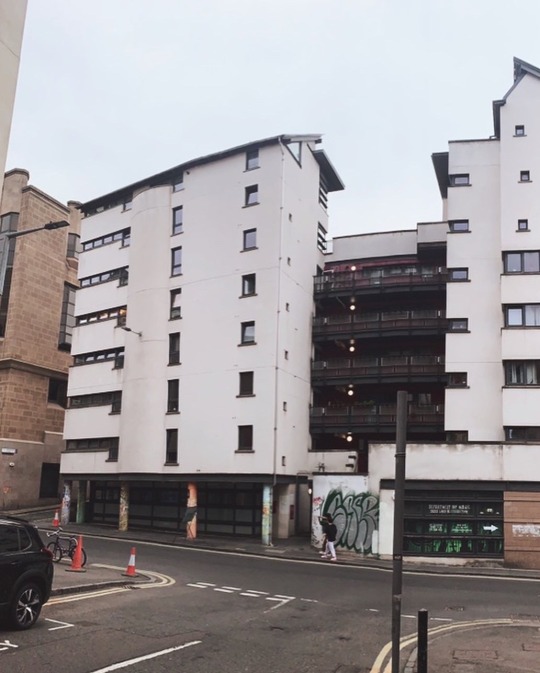
Crossing back to Old Town and down to Cowgate, two Richard Murphy projects. The first is a housing block - was hard to get a picture in full but I did my best. The grey and drab weather didn’t help make it look too appealing, and I do think it could use some cleaning up. My filters make it slightly better I think, but I guess I felt a tad disappointed haha.

Behind it is another on Old Fishmarket Close, and if Google is correct then I think Richard Murphy Architects is actually based there (or just around)? You may notice the picture is different because I took it the following morning to compensate for the mediocre lighting. I like this more than its neighbour; the material palette stood out especially! I love how the massing nods to the small older buildings below. Contextual acknowledgement is a big yes in my book - or maybe I should raise my standards.
☞ studygram
#studyblr#studyblr community#archiblr#architecture studyblr#architecture student#bookblr#dark academia#dark academia aesthetic#light academia#light academia aesthetic#writing#venetianwindow#heyzainab#studyvan#astudentslifebuoy#huitingreads#myhoneststudyblr#nihaohoney#heysantiago#heypeachblossom#architectingly#tusermelissa#problematicprocrastinator
5 notes
·
View notes
Text
In the year 2157, the world was a blend of the ancient and the ultra-modern, where cybernetic enhancements were the norm, and the night belonged to creatures of myth—vampires. But these were not the vampires of old legends; they were cybernetic vampires, beings who had merged with technology to become something new, something more dangerous and more fascinating.
The story begins in the sprawling megacity of Neo-Edinburgh, a place of neon lights and shadowy figures, where humans and cybernetic vampires coexisted in a tense balance. Among them was Lira, a young cybernetic vampire who had embraced her nature and used her abilities to become a detective in the city's underbelly, solving crimes that often intertwined the human and vampire worlds.
Lira was not like other vampires. Her enhancements allowed her to walk in daylight, shielded from the sun's harmful rays by her nanite-infused skin. She fed not on blood but on the electrical energy that powered the city, drawing it through her fingertips from the grid itself. Her latest case, however, would challenge her understanding of her own kind and shake the fragile peace between humans and vampires.
A series of mysterious disappearances had been occurring in the city, with victims vanishing without a trace from both the human and vampire communities. The only clue was a cryptic message left at each scene, a riddle that hinted at an ancient technology lost to time. As Lira delved deeper into the case, she discovered that the disappearances were linked to an ambitious cybernetic vampire, known only as The Architect, who sought to merge vampire and machine to an unprecedented degree, creating a hybrid entity that could control both the digital and physical worlds.
The Architect's vision was a utopia where vampires would no longer need to hide in the shadows, powered by a limitless energy source. But his experiments had a dark side, consuming the very essence of his subjects and leaving them as empty husks. Lira found herself torn between the allure of The Architect's vision and the horror of his methods. Her investigation led her through the neon-lit streets, into the heart of the cybernetic underworld, and finally to The Architect's hidden laboratory, a marvel of technology and horror.
In a climactic confrontation, Lira faced The Architect, using all her cybernetic enhancements and vampire abilities in a battle that tested the limits of her strength and resolve. In the end, it was not her physical strength that won the day but her understanding of both her human and vampire nature. She realized that the true power of the cybernetic vampires lay not in their enhancements or their thirst for energy but in their ability to bridge two worlds, to be both human and vampire, technology and nature.
Lira dismantled The Architect's operation, saving those who could be saved and exposing his experiments to the world. In the aftermath, the fragile peace between humans and vampires was strengthened, with Lira at the forefront of a new movement to integrate both communities more fully, using technology not to dominate but to understand and preserve the balance between them.
As the sun rose over Neo-Edinburgh, its rays reflecting off the chrome and glass of the city, Lira watched from her apartment, a figure of both the past and the future. She had become a symbol of what it meant to be a cybernetic vampire in a world where the lines between human and machine, natural and supernatural, were forever blurred.
0 notes
Text
Kitchen Design and Planning in Edinburgh: Crafting Your Culinary Haven
Introduction
The kitchen is often referred to as the heart of the home, and in the beautiful city of Edinburgh, where rich history meets modern living, creating a kitchen that marries aesthetics and functionality is a delightful journey. Whether you're renovating an existing kitchen or planning a brand-new one, meticulous design and planning are essential to ensure your kitchen becomes a culinary haven that reflects your style and caters to your needs. In this article, we'll explore the art of kitchen design and planning in Edinburgh, offering insights and tips to help you embark on this exciting venture.
The Significance of Kitchen Design

A Space for Creativity
Your kitchen is where culinary creativity takes flight. It's a space for experimenting with flavours, whipping up family favourites, and hosting memorable gatherings. A well-designed kitchen enhances your cooking experience and elevates the overall ambiance of your home.
Layout and Flow
Begin the design process by considering the kitchen layout. Common layouts include the galley, L-shaped, U-shaped, and island kitchens. Choose one that best suits your space and needs. Ensure a smooth flow from the cooking area to the prep and dining areas.
Cabinetry and Storage
Selecting the right cabinetry is crucial for storage and aesthetics. Edinburgh kitchens often feature a blend of traditional and modern design elements. Custom-made wooden cabinets, complete with stylish handles and fittings, add warmth and character to your kitchen.
Appliances and Fixtures
Invest in high-quality kitchen appliances and fixtures. Energy-efficient appliances not only reduce your utility bills but also align with Edinburgh's commitment to sustainability. Consider built-in ovens, induction cooktops, and innovative faucets to streamline your cooking process.
Lighting and Ambiance
Ample lighting can transform your kitchen into an inviting space. Embrace natural light and supplement it with task lighting, pendant lights, or under-cabinet illumination. Lighting not only enhances visibility but also adds to the overall aesthetics of your kitchen.
Edinburgh's Unique Kitchen Trends
A Blend of Old and New
Architectural heritage is a source of inspiration for kitchen design and planning Edinburgh. Many homeowners prefer to maintain traditional charm while infusing modern touches. Consider combining classic elements like exposed brick or wood beams with contemporary fixtures and appliances.
Sustainable Practices
Sustainability is a core value in Edinburgh. When designing your kitchen, opt for eco-friendly materials and energy-efficient appliances. Sustainable choices not only contribute to a healthier planet but also align with the city's eco-conscious ethos.
Smart Technology Integration
Edinburgh's residents embrace smart home technology. Incorporating it into your kitchen can enhance convenience and efficiency. Explore options like smart lighting, connected appliances, and integrated sound systems for a truly modern kitchen.
Planning Your Dream Kitchen
Budget Considerations
Determine your budget early in the planning phase. Having a clear financial plan ensures you make informed decisions throughout the process, from material selection to hiring professionals.
Work with a Professional
Consider working with a professional kitchen designer or architect. Their expertise can help you navigate the complexities of layout, materials, and aesthetics while ensuring your vision is realized.
Material Selection
Choose materials that are not only visually appealing but also durable. Granite or quartz countertops, hardwood or laminate flooring, and quality tiles are popular choices in Edinburgh's kitchens.
Personal Touches
Add your personal touch to the design. Whether it's a unique backsplash, a statement light fixture, or open shelving to display your favourite cookware, these touches make your kitchen truly yours.
Conclusion
In conclusion, designing and planning your kitchen in Edinburgh is an opportunity to create a space that reflects your personality and culinary passions. By embracing the city's unique architectural heritage, sustainability values, and modern technology, you can craft a kitchen that is both functional and aesthetically pleasing. The result? A culinary haven where you can create, gather, and savour life's finest moments.
0 notes
Text
Too Fast
Aziraphale Kiara. Crowley Lilian. Ineffable AU.
The blonde miracled a handful of bread crumbs into her pocket before tossing them out over the pond, watching the ducks scuttle forward to collect the food. Her other hand was tight around the handle of her parasol, the heavy fabric shielding her body as she joined her demonic associate.
“I’ve been thinking. What if it all goes wrong,” the dark-haired woman murmured, no question in her voice. “We have a lot in common, you and me.”
Kiara winced ever so slightly at the statement, the sense of unease natural at the comparison. Millennia ago, the difference had been smaller – primarily marked by their stations among the angelic. (Lilian was an architect, crafting galaxies and planets, as Kiara’s stature was lower, more akin to the builders who crafted the things inside the factories).
“I don’t know. We may have both started off as angels, but you –“ the word was pointed, sharp to emphasize their tenuous alliance, “- are fallen.”
“I didn’t really fall. I just … y’know,” Lilian scowled, “sauntered vaguely downward.”
The latest reminder that the dark-haired being wasn’t like the others doing Hell’s bidding. (“I go along with Hell as far as I can.”) It was just another way Kiara could justify this … partnership in her mind.
“I need a favor,” Lilian supplied, coming to the point of this rendezvous.
It had been decades since she’d seen the demon, vanishing in the Edinburgh graveyard. Years of discomfort at the uncertainty. If Lilian had slipped … had spilled their secrets. But there had been nothing from Heaven or the demon to signal a change.
(“Calm down, Angel. I’m not going to tell on you.”)
A favor. Not a demand.
“We already have our agreement, Lilian, to stay out of each other’s way.” She tossed some more crumbs out over the water. “Lend a hand when needed.”
“This is for something else,” the demon said, a slight hitch in her throat before she continued. “For if it goes pear shaped.”
“I rather like pears,” Kiara continued, trying to stall and gather her thoughts. They weren’t the apples packed with biblical symbolism, the orange with its sweet juice or the lemon and it’s acidic notes. Pears were pleasant, soft, agreeable.
“If it all goes wrong,” Lilian went on, “I want insurance.”
The angel’s heart raced. After all this time, the demon was showing her hand. “What?”
“I wrote it down,” her companion informed her, handing over the bit of parchment. “The walls have ears. Well, not walls, trees have ears. Ducks have ears.”
Kiara opened the note as Lilian looked around.
“Do ducks have ears? They must, to hear the other ducks,” the demon mused.
Normally, Kiara might have been amused by the tangent, the bit of levity she rarely got to see – unless poisoned by laudanum – but the words scribbled on the paper elicited a sharp gasp.
Holy water.
Her gaze rocketed to the demon, her lips parted in surprise. “Out of the question.”
This wasn’t leverage against her, to seal their bargain and their lips. This was … guaranteed destruction for the demon.
“Why not?” Lilian pressed lightly, not meeting her gaze.
As had happened over the years since the graveyard, Kiara wondered what had happened to the demon. What punishment had she endured to be seeking something so perilous to herself.
“Because it will destroy you,” the angel emphasized. “Absolutely not. I’m not giving you a suicide pill.”
Elspeth flashed before her eyes, the barely-not-a-child’s face thin and haggard from the stress of living. Lilian had seen the poison before Kiara and intervened before she could – but that was Lilian. Always too fast for Kiara.
Would Hell have ripped her down, if Kiara had been quicker?
Kiara handed back the note, the frown deep on her brow.
“That’s not what I want it for,” Lilian bit out, pushing the paper back into Kiara’s hand. “Just insurance.”
Something was not right. If it were just for protection, there were other outlets, ways that a demon of Lilian’s caliber and cleverness. And the Holy Water could just as easily be used against her.
“I’m not an idiot, Lilian,” Kiara hissed, her grip tight on the parchment. “If they knew I’d been … fraternizing. It’s completely out of the question!”
The demon turned to look at her, her jaw tight. If Kiara could see behind the black glass guarding her eyes, she wondered if they’d be unnaturally blue, flashing as they did with anger.
“Fraternizing?!” Lilian hissed.
“Or whatever you want to call it,” Kiara fired back, using this as a shield. She couldn’t do something that would hurt Lilian. Not when the demon was her closest ally on this plane. “I do not think there is any point in discussing it further.”
“I have a lot of other people to fraternize with, Angel,” the demon snapped.
For a second, Kiara winced at the sharpness of the endearment, normally so playful.
“Of course you do,” the angel retorted, turning away out of frustration.
“I don’t need you,” Lilian said.
Kiara turned back to see the scowl, indignation rising within her. “The feeling is mutual. Obviously.”
They didn’t need each other. This was merely convenience.
She threw the note into the pond, storming off as the paper caught fire.
If she didn’t need Lilian, then why did the thought of not having her hurt?
~*~
Kiara shifted the thermos from hand to hand, staring past the easels and pedestals at nothing in particular as she weighed her next steps.
It wasn’t as if she kept tabs on Lilian – neither of them did really, just heard rumors and whispers of activity that sounded right for each other, or reaching out when they needed to meet.
LiLi was almost always the one finding her. In Paris. In Edinburgh. In St. James’ Park.
But the murmurs Kiara was hearing were buried deep, things that wouldn’t go noticed unless somebody was truly listening to them. Which the angel had started doing shortly after their adventure in 1941.
(“Look at that. A whole font full of Holy Water,” the demon marked, shifting uncomfortably from foot to foot in the hallowed ground. “Doesn’t even have guards.”)
Kiara had been too occupied with the Nazis to pay too much attention to the comment. And afterword, she was too focused on her introduction on the Prestigious West End Stage.
Now, the contents of her hands heavy, she could do nothing but focus on it.
It’d be more than a hundred years since Lilian had first asked for the weapon, since Kiara had vehemently rejected the notion of giving something so dangerous to her best friend. But if she was plotting something so risky as a heist on hallowed ground … Kiara would rather eliminate some of the peril herself.
Hell was a dangerous place. Their near exposure in London had reminded her of that. When that demon had waved the photo triumphantly in their faces, gloating about how LiLi was going to be punished, Kiara’s heart had nearly beat out of her chest. (“The Miraculous Bullet Catch requires the aid of a trusted stooge and confidant.” The dead Nazis, their bodies bloodied and rotted. The photo. “Enjoy your last night on Earth.”) She’d only managed to mask it through mastery of her stagecraft, using the tricks taught to her by the Great Prof. Hoffman.
In her centuries on Earth, she had never faced that kind of threat. But then again, what other threat did Hell have besides torture or destruction? Heaven, if they didn’t banish angels to Hell for the terrible sin of blasphemy, would simply bury somebody under paperwork.
(“Just insurance.”) Please let this be one of the times Lilian didn’t lie.
The Bentley was easy to find in Soho, as distinctive and sleek as its owner. Kiara waited as Lilian finished whatever conversation she was having with that unscrupulous character and sauntered back to the car. As the dark-haired woman slid behind the steering wheel, the angel used her more … frowned upon abilities to appear in the passenger seat.
“What are you doing here?” Lilian asked, only a hint of surprise in her voice.
Kiara gave a tight smile before she stared out the window. “I needed a word with you.”
“What?”
She could feel Lilian’s gaze on her, her eyes still hidden behind the black frames, and she fought the urge to wiggle under the intensity of such scrutiny.
“I work in Soho. I hear things. I hear that you’re setting up a –“ she paused and licked her lips before she turned toward her friend, “caper. To rob a church.”
Lilian looked out the windshield, not bothering to deny the allegation.
“LiLi, it’s too dangerous,” the angel pressed frantically, trying once more to communicate the severity of this gift. In case she had lied again. “Holy Water won’t just kill your body, it will destroy you completely.”
“You told me what you think,” Lilian drawled nonchalantly as she met Kiara’s wide gaze. “105 years ago-“
“And I haven’t changed my mind!” Kiara asserted quickly, with a small shake of her head. She could practically feel the dark-haired woman roll her eyes behind her glasses as Lilian looked away. “But I can’t have you risking your life. Not even for something dangerous.”
She pulled the thermos out of the darkness, lifting it gingerly as if going too fast would shatter the container and destroy Lilian. “So … You can call of the robbery,” she offered as she held her gift out to her companion.
Lilian looked between her and the thermos incredulously several times before she carefully accepted it.
“Don’t go unscrewing the cap,” Kiara said as she tried to swallow her discomfort.
The neon lights of Soho’s nightlife reflected off the thermos, painting Lilian’s beautiful visage in bright hues that Kiara itched to capture … even if it was something as ordinary as one of those newfangled cameras.
“Is this the real thing?” Lilian questioned as she studied Kiara’s face.
“The holiest,” the blonde promised, searching Lilian’s face for any sign that she’d been wrong.
“After everything you said?” There was a quiet sense of awe in the words. As if she couldn’t believe that somebody would do something to help her like this, after all these years. (“You said trust me.”)
Kiara nodded quickly, turning away from Lilian’s disbelieving expression to stare out the windshield at the world around them. Safe here, in the Bentley.
“Should I say thank you?”
The blonde swallowed several times, her lips pressed tightly. “Better not.”
“Well, should I drop you anywhere?”
Kiara had to get out of here before her tongue got the better of her and she begged Lilian not to use it on herself. To make her promise that she hadn’t lied.
“No, thank you.” Kiara shook her head slightly and forced an uncomfortable smile on her face at the barest hint of an expression on Lilian’s face. “Oh don’t look so disappointed. Perhaps one day, we could … I don’t know. Go for a picnic. … Dine at the Ritz.”
Both were practically impossible. Not when Heaven and Hell were both watching.
“Look, I’ll give you a lift. Anywhere you want to go,” Lilian promised, gesturing out over the city through the windshield.
Maybe Lilian could be on her own side. Ignore Hell’s rules to live by her own special code and blur the edges but that was because she was a demon. She could make her own choices.
And Kiara?
Kiara swallowed, the offer hanging in the car. “You go too fast for me, LiLi.”

0 notes
Photo

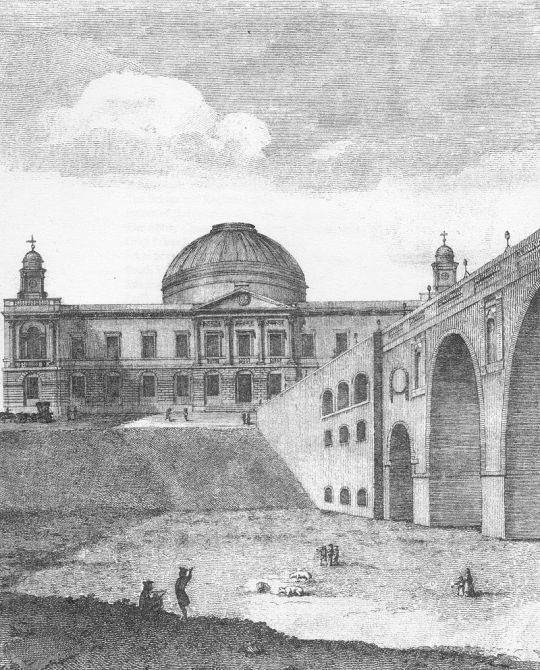
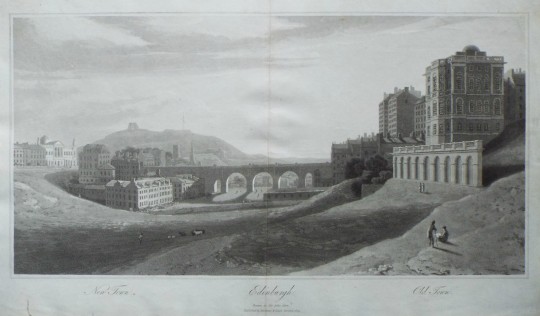




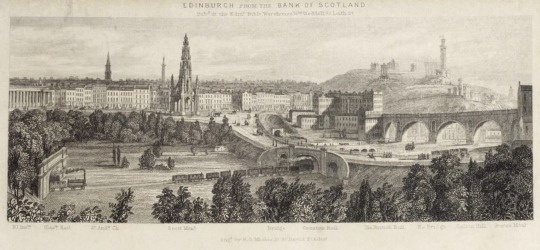








On October 1st 1763 the contract to build Edinburgh’s North Bridge was signed.
Edinburgh in the 1700′s was a very different city to the one we know today. The city boundary was restricted to the dramatic crag and tail feature which swept eastwards from the castle. Up to 35,000 people inhabited a space under a mile long making Scotland’s capital one of the most densely populated urban areas in the world at that time. The overcrowded population were crammed into crumbling tenements, many of them up to fourteen storeys high in order to make the most of the limited space. Make no mistake, Edinburgh at this point in it’s history, was a skyscraper city, very few cities in the world had buildings the height of our capital!
Edinburgh’s nobility were often forced to accept the unthinkable and share dwellings with the lower classes. Change was not just desired, it was deemed an absolute necessity if the city was ever to move forward.
Plans to build a New Town to the north were discussed as early as the 1750s but without the means of connecting it with the rest of Edinburgh, it would be nothing more than a fanciful dream. Phase one required the draining of the ancient Nor’ Loch, a man-made stagnant body of water located in the area which we now term as Princes Street Gardens. Drainage began in 1759 and would continue up until the 1820s. Dry land at the east of the Nor’ Loch valley allowed for what was undoubtedly the most ambitious engineering project to have been built in the city at that point: An eleven-hundred foot long stone bridge. The North Bridge, as it would be named, enabled the New Town to become a reality. A brand new chapter in the city’s history was about to begin.
The foundation stone of architect William Mylne’s North Bridge was laid in October 1763 but it would be a further two years before any serious amount of progress was made. The magnificent multi-arched bridge first opened to pedestrians in 1769 to much fanfare and excitement. However, the cheers quickly died down in August of that year when a partial collapse claimed the lives of five people. Haste in construction and a poorly calculated estimate regarding the depth of the foundations were said to have been the primary cause. Rebuilding work demanded £18,000 (almost double the original cost of the project) and the city would have to wait until 1772 before the grand reopening.
The North Bridge consisted of three main arches and several smaller arches, many of them concealed, on either side. After the bridge’s final completion, building work on the first residences of the New Town would commence within five years. Edinburgh would go on to expand like never before as the world’s largest Georgian townscape began to take shape.
The much-anticipated bridge was only to last a little over a century. Redevelopment and expansion of Waverley train station was being held back by the narrow space available between the piers of the North Bridge. It was becoming obvious that a new link was needed. Construction of the current steel bridge that we know today was completed in 1897 at a cost of £81,000. The North British Railway Company contributed to a third of the cost.
There are now several bridges in the city but it is the North Bridge which is most visible. Today the bridge continues to play a vital role in dictating the ebb and flow of the city, much as it has done for the past 240 years and at the moment work is continuing on a major restoration after defects were discovered in 2014, the work which was to cost an estimated £22 million, but if you recall my pic of the mural a couple of weeks ago, I pointed out the project is way behind schedule and the costs are now standing at £32 million, the work however will secure the bridge for many years to come for the future citizens and visitors to the capital to both enjoy and use.
Okay the pics from top to bottom, the old bridge circa 177, 1800, note nothing built on the North side, with the view straight through to Register House, thenm, 1809, 1824, 1829 (x2), 1837, 1845, 1871, 1966,1970, 1977, 2012, 2020 and finally my own pic from 16th September this year.
35 notes
·
View notes
Text
Minimalism in Interior Design: The Beauty of Simplicity

Introduction to the Aesthetics of Minimalism
In today's fast-paced world, where the hustle and bustle of everyday life can be overwhelming, more and more people seek peace and harmony in the interiors of their homes. It is precisely in such moments that minimalism in interior design becomes not only a popular trend, but also a way to create a beautiful and functional space that fosters relaxation and focus. By designing interiors with a minimalist approach, the designers at TopInteriorDesign.co.uk understand that less can mean more - and that simplicity can exude a unique charm.
Minimalism in Interior Design
Clean lines and simple forms: Minimalist interiors are characterized by clean and readable lines. Furniture and accessories with reduced shapes add elegance and a special allure to the space.
Limited color palette: Neutral, subdued colors such as white, gray, beige, or black dominate minimalist arrangements. This creates a calm atmosphere, conducive to tranquility and relaxation.
Functionality at the forefront: Minimalism does not mean a lack of functionality. Interior designers from Edinburgh, working at TopInteriorDesign.co.uk, pay attention to every detail to provide practical solutions and optimal use of space.
Open space: Minimalist interiors often emphasize spaciousness. Removing unnecessary items and limiting the number of pieces of furniture allows for easy movement and gives the impression of more space.
Minimalism: More Than Just a Style
Minimalism in interior design is much more than just another decorative style. It is an approach to design that combines the art of reduction with practicality, allowing the creation of spaces that reflect the character of their inhabitants. Collaborating with TopInteriorDesign.co.uk, interior architects in Edinburgh utilize minimalism as a tool not only to create aesthetic spaces but also to design functional and ergonomic living areas.
Minimalist Furniture and Interior Finishes
Furniture and interior finishes play a crucial role in projects based on minimalism. Designers from Edinburgh, collaborating with TopInteriorDesign.co.uk, carefully select furniture with reduced forms, made from high-quality materials. Simple yet carefully crafted elements introduce elegance and style to the interior without overwhelming it with excess decoration or unnecessary details.
Key Features of Minimalist Furniture and Interior Finishes
The use of natural materials such as wood, concrete, or stone adds coziness and authenticity to the interior.
Clear surfaces, smooth and pattern-free, contribute to the minimalist aesthetic.
The functionality of furniture takes precedence: storage compartments, cabinets, and shelves conceal unnecessary items, making the space feel more organized.
Interior finishes, such as simple, monochromatic wallpapers or smooth textures, complement the minimalist style.
Minimalism in Practice: Designing with Soul
Minimalism in interior design is not just a set of rules or specific elements. It is a philosophy that shapes the surrounding space. Interior designers at TopInteriorDesign.co.uk understand that minimalism can be personalized and tailored to each client's individual needs. Introducing minimalism into an interior is an art that requires a sense of balance and proportion. With the right vision and creativity, minimalist projects acquire character and uniqueness, revealing the full beauty of simplicity.
Interiors based on minimalism are an expression of subtle elegance, accompanied by thoughtful functionality and spatial harmony. Designers from Edinburgh, at TopInteriorDesign.co.uk, have mastered the art of minimalist design, creating interiors that perfectly reflect the taste and style of their clients.
Collaborating with the TopInteriorDesign.co.uk team, you can be sure that your interior will be designed in the spirit of minimalism; the beauty of simplicity will become your everyday companion, and the surrounding space will be an oasis of peace and serenity.
1 note
·
View note
Text
Sygma Cadd Ltd Launching Steel Detailing in UK For Your Construction Project
The field of technology and its application in several businesses have grown recently. The Sygma Cadd Ltd industry's prospects are radically altered by new working methods. This includes utilizing a number of contemporary technological tools that facilitate the planning and construction processes. In order to establish functional designs and effectively manage materials, structural Steel Detailing UK services are increasingly crucial to the success of any building or construction project.
Drafting plans for fabricators and contractors is the first step in the steel detailing process. This covers a project's planning, reports, and estimates. Erection drawings and shop drawings are the two primary drawings that will be used in steel detailing.
Erection Drawings
These significant drawings by Sygma Cadd Ltd will provide a visual representation of a steel-based project's proportions. Erection drawings provide a view of the entire structure and explain the precise location of each steel component in a project, the steps required to install them correctly, and any essential diagnostic data regarding required materials, such as bolts and anchors. These Structural Drafting UK drawings will serve as the blueprint for all project components that will be built using things that are manufactured using shop drawings.
Saves Time
The creation of the many designs and their nuances could take a while. You can outsource and have a reputable company provide all of the tasks you need rather than expending all of that time and effort. Choose the Tekla Drafting Services UK you need, then assign the remainder to your team.
Save Money
Cost savings may be significant. You won't have to pay for CAD software or hire an internal engineering team if you choose to outsource. This makes sure that your needs are met without you having to pay the internal team for their services.
Steel Detailing Standards & Expectations
A steel detailer is in charge of upholding the highest standards for every project, anywhere in the world.
The steel detailer serves as a crucial link between the structural engineer and the architect by providing drawings that serve as guidelines for the Structural Design UK, durability, and structural integrity of steel structures. After they are finished, the detailer will ask the architect and structural engineer for their approval before beginning any fabrication.
Large structures must be built with complete accuracy, or they may collapse in the event of a fire, storm, or earthquake. Steel detailing is crucial to minimizing these dangers. Because of this, architects rely on steel detailers who possess advanced technical aptitude for creating site maps and drawings. The joists and massive iron beams, however, also require equal attention; simply ensuring detailed reporting, column arrangement, and fabrication details is not sufficient. For the building to be strengthened, they must be precisely positioned.
Even while this is simple for little buildings, it is more difficult for big commercial structures. Therefore, to complete the task successfully, expert Steel Detailing UK are needed.
About Sygma Cadd Ltd
SYGMA CADD Ltd is an independent company based in Edinburgh, UK, which offers a complete steel detailing and CAD services to fabricators and design consultants. We utilize the latest 3D steel detailing technology along with a team of highly professional steel detailers to produce steel details according to both the British and Euro standard codes. We tailor both fabrication and erection drawings according to the needs and standards of each steel fabricator we work alongside.
Head Office (UK)
Reg No: SC689992
31 Chuckers Row,
Wallyford,
Edinburgh UK,
EH21 8JP
Telephone : +44 131 281 4982
0 notes
Text
Bridge 63, South Bridge, Edinburgh
Bear with me on this, it’s a bit complicated, especially if you are not familiar with the fine city of Edinburgh. The word “burgh”, usually now understood to mean town, originally meant fort, and that is what Edinburgh was. It provided a grand place for a fort, high on a precipitous ridge of rock, surrounded by other ridges, with water between them, so the only access to the castle for ages was a steep road along the top of the ridge, now the Royal Mile. So, easy to defend. Nevertheless, after the muddy defeat of the Scottish at Flodden Field, the Edinburgh residents felt nervous enough to build a wall around their town. This all made it very difficult to expand. The people who wanted to live in the growing town had nowhere to build their houses but the steep sides of the ridges. Because of the severe shortage of land for building, and possibly to see the amazing views, they built tall tenements. Eventually, even tough Scottish folks got fed up with trudging up and down the narrow paths between them, and then having to face several flights of stairs to the front door. So, bridges were needed to get from the top of one ridge to the top of the next, but all the space was full of tenement buildings, which were full of people. The only possibility was to build the bridges along the lines of paths between the tenements, at about the level of the third floor, leaving the lower floors in the arches of the bridge, and completely cut off from access to the outside, and daylight. Such as there is in Scotland.
South Bridge was designed by Robert Adam (see Bridge 43, Pulteney Bridge), a local lad, and in my view one of the best architects there has ever been (just take a look at Mellerstain House). He began work on the bridge in 1785, but of course because it is squashed between the tall buildings, you can’t see much of its magnificent 19 arches (the highest about 10 metres).

An arch over Cowgate, that you can see, also showing how the bridge disappears between the buildings on each side of Cowgate

And this is the bridge deck of south Bridge during the 2022 Festival
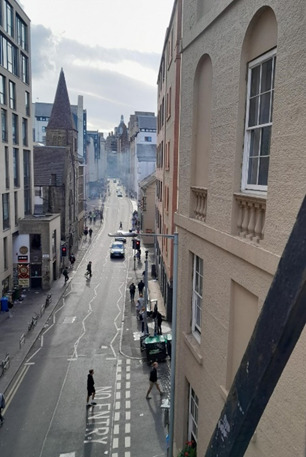
This is the view of Cowgate from the bridge, which give a bit of an impression of how high it is
The bridge was constructed along the line of the paths between buildings on Marlin’s Wynd, Peebles Wynd and Niddry’s Wynd (narrow pathways), and crossed the road at the bottom of the valley, Cowgate. Some buildings were demolished to make the bridge wide enough to be useful. I can find no information on what happened to the poor (extremely poor, and utterly powerless) people whose homes were destroyed by this, but we know the stones were re-used to build the bridge.
The interesting bit, of course, is the spaces that were enclosed. I think the original plan was to use these dark spaces as storage, so floors were built in the enclosed arches, and access was retained. I think it is really impossible now to find if there are any true bits in the stories that accumulated, but they are fun. To start, the plan was for city’s eldest resident – a judge’s wife – to be the first to cross the bridge in a triumphant and thrilling opening ceremony. The obvious flaw in the plan rather spoiled the atmosphere. The lady died a few days before the party. For some reason, the party planners had no plan B, and she crossed the bridge in her coffin (see coffin bridges, I might get to that). This had the effect of making living people a bit uncomfortable about using the bridge, and many preferred to continue to take the steep climb instead. This creepy start probably helped fuel further stories. There have been rumours of all kinds of nefarious uses for these places, as they would have made ideal places for activities that anyone wished to keep out of sight. They start with a craze for the rich to buy edgy fashion items such as hats and shoes, or meetings of the Hellfire Club, for rich men to indulge in drinking, gambling, dressing-up, illicit sex, political conspiracies and other generally disapproved behaviour. Much worse, it is suggested that greedy and uncaring landlords let rooms to the poor and desperate, that children with plague were locked up there to die, and that Burke and Hare hid their murder victims there, and took them though a secret passage to the anatomy department of the university.

One of the underground arches of the bridge
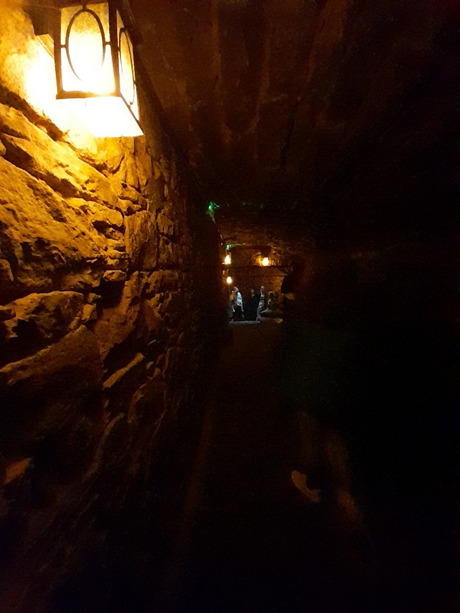
All of this was over in less than 50 years, as the Council recognised the spaces were dangerous, and blocked all the access points, and so it stayed until the 1980s, when the landlord of the Tron pub found a passage entrance in his basement, and began to dig. He excavated enough space for bands to rehearse and perform, and (apparently) for a defecting rugby player, Cristian Raducanu, to hide from the Romanian secret police. You can now take a tour.
0 notes
Text
As a Ph.D. scholar at the Australian National University (ANU) from 2004 to 2007, I stayed at the University House. I chose to live there because it is near my Coombs Building office. It was only halfway through my studies that I appreciated its rich history dating back to its establishment in 1954 as the oldest residential college at the university.
The University House has undergone significant changes to meet the diverse needs of its residents. Originally designed to house academic units and later as a residence for faculty, staff, and postgraduate students, the building has transformed into a multifunctional space that seamlessly blends historic charm with modern amenities. The dormitory section where I lived serves as housing for Ph.D. Students, the rest of the building has been converted into 150 hotel-style rooms for visitors.
Designed by architect and professor Brian Lewis, the University House is recognized as a heritage site by ANU, the Royal Australian Institute of Architects, and the Government of Australia.
The ceremonial opening of the University House in 1954, graced by Prince Philip, Duke of Edinburgh, marked a significant milestone in its history. Over the years, the building has adapted to changing times and needs, transitioning from the traditional Oxbridge collegiate system to that of a manor with facilities attuned to the 21st century.
The University House has been a venue for numerous academic and social gatherings, including traditional Oxbridge formal dinners and free wine tastings for Ph.D. residents on Wednesday evenings. Its illustrious history is further enriched by the distinguished individuals who have resided within its walls, such as Australian Prime Minister Gough Whitlam.
A standout moment during my time at the University House was the visit by Crown Prince Frederick and Crown Princess Mary of Denmark in 2005, during which a memorandum of understanding was signed between ANU and universities in Copenhagen and Aarhus. It was unforgettable because I was busy writing my dissertation in my office daily from 12 noon till 5 a.m. I did not receive last-minute word about vacating the dorm premises after breakfast because Danish guests will be passing through. I was showering leisurely before noon, after waking up, minutes before the VIPs dropped by, when security knocked and slipped a note under my door, frantically instructing me to get properly dressed ASAP.
The University House has become a heritage-listed boutique hotel with various dining options and event spaces. Despite facing challenges like the hailstorm damage in January 2020, the building is resilient and undergoing restoration to continue its legacy of academic excellence and cultural significance for future generations to appreciate. As University House continues to thrive, its importance within the ANU community remains unwavering, ensuring its place in its rich history for generations to come.
#australiannationaluniversity
1 note
·
View note
Text
How to Set Up As Self-Employed - Some Simple Advice
New Post has been published on https://www.fastaccountant.co.uk/how-to-set-up-as-self-employed/
How to Set Up As Self-Employed - Some Simple Advice
There are many people who would like to become self-employed and will like to know how to set up as self-employed. In the UK, the process is not that complicated. It just requires a few careful steps to start off. In this article we are going to be looking at some of the essential steps that will help anyone understand how to set up as self-employed.
Make a plan on how to set up as self-employed
If you want to become self-employed, you must first make a plan on how to go about it. You need to have a marketable product or service to sell, as well as an understanding of how and where to market it. If you are going to have a period where no money is coming in during the early stages of your self employment make sure that you have planned for sources of funds during this period. This will allow you to cover for your living expenses during the early stages.
Choosing a business name
Choosing a business name for your business is an important step in the self-employment process. It is important to choose a name that is memorable and reflects what you do best. For example, if you are a plumber in Edinburgh, you may choose the trading name Edinburgh Plumber to reflect the type of service that you provide and in this case the arear that you are in.
When choosing a name for your business, try to choose a unique name that reflects what you do and the benefits your business provides. Start by thinking about what you want to offer and what image you would like to project. This way, you can choose a business name that reflects your business image and attracts new customers.
Registering with HMRC
Registering with HM Revenue and Customs as self-employed requires a few simple steps. First, you need to create an account on the Government Gateway. You’ll need a user ID, password, and full name. You’ll also need to know when you became self-employed. After you’ve established your account, you can start filing your tax returns.
Keeping good financial records is essential for any business. It helps you keep track of day-to-day sales and expenses, and also helps you create accounts at the end of the year. Hiring an accountant to help you keep track of your finances is not only cost-effective, but it can also ensure you’re not in trouble with HM Revenue and Customs.
Liability insurance
If you are setting up as self-employed, you need to take out liability insurance for your business. General liability insurance is one of the most common forms of business insurance for self-employed individuals. It protects you against third-party claims for property damage or bodily injury. It can be especially important if you are a consultant, architect, accountant or real estate broker.
Costs of being self-employed
Self-employment can offer a lot of benefits, including the freedom to work where and when you want. As the boss, you can make your own hours and choose the people who work with you. You can also set your own schedule and manage your finances. However, there are some costs associated with being self-employed. You need to pay your own income taxes and manage your personal finances. Self-employment can be a great opportunity for people with creative ideas.
Choosing the right structure for your business
Choosing the right structure for your business is a very important step when setting up as self-employed. It can have a huge impact on your day-to-day operations, taxes and liability. It is important to select a structure that offers the right balance of protection and flexibility. A business can be set up as a sole proprietorship or as a corporation or partnership, and each structure has its advantages and disadvantages.
A sole proprietorship is ideal for a small business that doesn’t plan to expand too quickly. It can allow you to save time and money by avoiding complicated legal and administrative tasks. Having a sole proprietorship can also allow you to focus on developing your business rather than on legal and tax compliance. A sole proprietorship is also ideal for businesses that involve very few employees and can be run by one person.
Recordkeeping requirements
Recordkeeping is an essential part of running a self-employed business. It helps you prove that you earned an income, incurred expenses and purchased or sold some business assets. In addition, it helps you pay the correct amount of tax. Self-employed individuals are required to keep a record of their expenses and all business-related transactions, including invoices and bank statements.
Whether you work from home or work part-time, it is vital to keep records of all business transactions. It is also important to update these records on a regular basis. You may use a computer log book to track your transactions. You will also need to keep copies of bank statements as evidence of your income and expenses from self-employment.
Legal requirements
When you’re first starting a business, it’s important to know the legal requirements in your chosen field for setting up as self-employed. For example, in some professions, you are required to have a professional indemnity insurance In order to operate a business in that profession. Some good examples are Accountancy, Dentistry and solicitors. Another good example is the construction industry. If you want to work in the construction industry and provide your services as a subcontractor in the Construction industry, HM Revenue and Customs requires that you register for the Construction industry scheme otherwise known as CIS for short.
youtube
As you can see, there are many options available to anyone who wants to try to take control of his or her own way of making a living. If you are looking for a way to become your own boss or you want to turn your hobby into a productive business, setting up as self-employed can be easy when you take the time to do research. Take your time, don’t rush, and you will soon find that starting up your own business is not that difficult after all!
0 notes
Text
Homes For Scotland 2022 Awards winners news
Homes for Scotland Awards 2018, Residential Buildings, Scottish Housebuilders Prize Shortlis, Architects Practices News
Homes For Scotland 2022 Awards Winners
23 May 2022
Trio Of Wins For Scotland’s Home Builders At Industry Awards
Three of Scotland’s home builders are celebrating winning headline awards at the return of trade body Homes for Scotland’s (HFS) annual ceremony held in Edinburgh last Friday 20 May.
Homes For Scotland 2022 Awards Winners News
The event, which was attended by some 1,000 senior industry representatives and their guests, saw Cruden Homes take the award in the large home builder category, with Whiteburn Projects being celebrated as top SME and CCG (Scotland) crowned Home Builder of the Year (Affordable Housing Provider).
The three home builders were selected by the independent judging panel for their approaches to “going the extra mile” to deliver developments or practices which stood out from the crowd.
With all shortlisted development entries subject to a site visit by the panel as well as a separate online interview with senior management representatives, judges were hugely impressed by the headline winners, noting demonstrations of strong community engagement, high levels of customer satisfaction and a commendable focus on innovation across the board.
Chair of the independent judging panel David Knight, former Managing Director at Avant Homes, said:
“As Chair of this year’s refreshed judging panel, I was delighted to see such strong submissions from HFS members, particularly given the challenges of the past couple of years.
“These entries showcased organisations which are not only rising to the challenge of delivering more of the much-needed homes we require across the length and breadth of the country but are doing so in a way which goes above and beyond – that could be in terms of their use of innovative technologies or building techniques, creation of a sense of place and community or notable sustainability features – and all with the customer to the fore.
“The panel therefore congratulates all who entered and those taking home the top awards.”
A full list of winners: Homes for Scotland Awards 2022 Winners.
Tthe headline Home Builder of the Year winners – The winners of the 2022 Homes for Scotland Annual Awards were announced in front of 1000 senior industry representatives and guests at the organisation’s Annual Lunch, with Cruden Homes scooping Large Home Builder of the Year (1). Whiteburn Projects were announced as top SME (2), with CCG (Scotland) crowned Home Builder of the Year (Affordable Housing Provider) (3).
Development of the Year – Large:
Link Group & McTaggart Construction – Riverside Dalmarnock, Glasgow (winner)
Development of the Year – Medium:
Westpoint Homes – One Hyndland Avenue, Glasgow (winner)
Development of the Year – Small:
Cruden Homes (East) – Muirwood Gardens Phase1, Kinross (winner)
PANACEA homes – The Primary, Glasgow (commended)
Previously on e-architect:
Homes For Scotland 2022 Awards Shortlist News
23 March 2022
Homes For Scotland Announces 2022 Awards Shortlist
Home building body Homes for Scotland (HFS) has announced the shortlist for its 2022 awards programme as it plans for a return to the largest annual gathering of its kind where winners will be announced.
With a focus on “going the extra mile” to deliver developments or practices which stand out from the crowd, those companies making the judges’ first cut are:
Homes For Scotland Awards winners in 2019:
photograph © Chris Watt
Homes For Scotland 2022 Awards Shortlist News
Development of the Year – large (100+ units)
sponsored by Hacking and Paterson
Barratt and David Wilson Homes
The Strand, Edinburgh
CCG (with South Lanarkshire Council hub South West)
Whitlawburn Regeneration, Glasgow
Link Group & McTaggart Construction
Riverside Dalmarnock, Glasgow
Places for People
Chapelton, Aberdeenshire
Springfield Properties
Bertha Park, Perth
Stewart Milne Group
Dunnottar Park, Stonehaven
Development of the Year – medium (26-99 units)
sponsored by VELUX
CALA Homes (East)
Boroughmuir Phase 2, Edinburgh
CCG (with City of Edinburgh Council)
Bingham Avenue, Edinburgh
Cruden Homes (East)
Bonnington Mill, Edinburgh
Lovell Partnerships
Claish Farm, Stirlingshire
Westpoint Homes
One Hyndland Avenue, Glasgow
Whiteburn Projects
Caerlee Mill Phase 2, Innerleithen
Development of the Year – small (up to 25 units)
sponsored by Openreach
Cruden Homes (East)
Muirwood Gardens Phase 1, Kinross
Hadden Homes
Glenluie Green, Perthshire
Panacea Homes
The Primary, Glasgow
Rural Renaissance
Darnick Green, Melrose
Innovation of the Year (Transition to Net Zero)
sponsored by Shoosmiths
Barratt Developments
The Z House
Pixel
Online selection systems
Stewart Milne Group with Barratt Developments and Forster Group
AIMCH Project
Associate Member of the Year
sponsored by Anderson Strathern
Winner announced at the HFS Annual Lunch, with no prior shortlist released
With last year seeing an amalgamated 2020/21 shortlist and virtual awards showcase due to restrictions caused by the pandemic, updates to 2022 categories include a focus on the transition to net zero within the Innovation of the Year category – designed to showcase examples of real innovation within the sector as it contributes to a national commitment of net zero emissions by 2045.
In a further change, no prior shortlist has been released for the Associate Member of the Year category, with members of the HFS senior management team asked to nominate candidates within the HFS membership who have gone the extra mile, engaging with the organisation’s work and providing vital support to other members over the course of the year.
Reflecting the programme’s ongoing robust judging process, the independent panel will be undertaking site visits to all those shortlisted in the Development of the Year categories alongside corresponding online interviews to determine who will take one of three headline Home Builder of the Year awards. Those shortlisted under the Innovation of the Year (Transition to Net Zero) category will also be invited to an online interview.
Winners will be revealed at the Homes for Scotland Annual Lunch (sponsored by Burness Paull) at the EICC on Friday 20 May which will be hosted by impressionist and comedian Jon Culshaw. Over 900 senior industry representatives and guests are already confirmed to attend what remains the date in the Scottish home building industry calendar.
Chair of the independent judging panel David Knight, former Managing Director at Avant Homes said:
“I was delighted to be asked to Chair this year’s refreshed judging panel and have been hugely impressed by the demonstrations of “going above and beyond” which have been evident throughout the entries received.
“Whether that be examples of innovation, diversity, sustainability measures or meeting customer needs, HFS members have shown their commitment to delivering high quality places for people to live during what remain difficult circumstances.
“With the judges now set to embark on the site visit and interview stage of the process, I am very much looking forward to seeing these submissions come to life and to the difficult task of deciding upon the winners.”
The independent judging panel comprises:
David Knight (Chair) – Former MD, Avant Homes
Johnny Cadell, Principal Architect & Designer, A+DS
Emma Marriott, Director, Emma Marriott Consulting and Board member of Construction Scotland Innovation Centre
Andy Mason, Head of Strategic Partnerships & Housing, Lloyds Banking Group
Scott Peterkin, Partner, Burness Paull
Sarah Stanger, Former Sales & Marketing Director, CALA Homes (East)
Jane Tennant, 2022 Chair, Scottish Young Planners’ Network
Carrie Thomson, Principal Planner, Scottish Government
Previously on e-architect:
Homes for Scotland Awards 2018
Shortlist for Homes for Scotland Awards 2018
Homes for Scotland Awards
Homes for Scotland Awards Shortlist 2016
Homes for Scotland Awards 2016
Location: Scotland
Scottish Architecture
Scottish Architecture Designs – chronological list
Scottish Architecture News
Scottish Houses
Contemporary Scotland Architecture Designs – architectural selection below:
Justice Centre in Inverness
image courtesy of architects
Justice Centre Building in Inverness
image courtesy of architects
Studioshaw win competition for new Interactive Hub for RIAS Dundee
image courtesy of architects
Interactive Hub for RIAS Dundee
Scottish Housing
Scottish Architecture
Scottish Housebuilding
Scottish Housing
Highland Housing Fair
Scottish House
Highlands House
Historic Scottish Houses
UK Architecture Awards
Stirling Prize
Civic Trust Awards Scotland
RIAS Award for Architecture
Saltire Awards
RIBA Awards Scotland
Comments / photos for the Homes For Scotland 2022 Awards Shortlist page welcome
The post Homes For Scotland 2022 Awards winners news appeared first on e-architect.
0 notes
Text
ltdan2288 asked: As a fellow veteran of the Afghan Campaign, might I ask if you have any thoughts about the imminent end of Allied air support & combat-advisory operations over there? The fall of large swaths of the country to the Taliban is already underway, which can only be seen as an unspeakable tragedy for the people there. From a strategic perspective, there’s no reason to believe that we won’t have to return in some capacity of AQ or ISIS reestablish themselves under Taliban sponsorship. At the same time, it’s not clear to me that our presence did anything beyond kick the can down the road and delay this inevitable outcome. As someone with such a deep knowledge of military history, I’m curious if you have a different perspective.
I have been avoiding answering this post for a while now because Afghanistan dredges up so many conflicting emotions inside me. I wrestle with so many memories of my time there with my regiment to fight in a war that we all didn’t really understand what we were fighting for.
Deep breath.

Almost two decades of conflict in Afghanistan has cost British taxpayers £22.2billion, or $31.3 billion according to UK government figures. As British troops prepare to leave Afghanistan, the 20-year deployment bill could be even higher. As of May 2021, the total cost of Operation Herrick (codename for the deployment of British soldiers to Helmand province) is £22.2billion. There were 457 fatalities on, or subsequently due to, Op Herrick. Of which 403 were due to hostile action. During the operation between January 1, 2006 and November 30, 2014, there were 10,382 British service personnel casualties. Of these 5,705 were injuries and the remainder being illness or disease. The UK’s remaining 750 troops in Afghanistan, involved in training local forces, started exiting the war-devastated country in May. Most of them will return home by the end of July.
They, like every one of us who went to fight in Afghanistan, will ask the same questions, ‘Why did we go there?’ ‘What was the real purpose of the mission?’ ‘Was it worth it?’
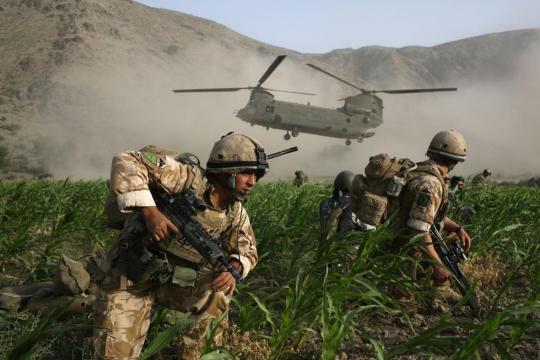
Both my older brothers fought there with special distinction and I later fought there too. I have very mixed emotions when I think about my time in Afghanistan. For all its faults and tortured history, I love that country and love its many ethnic people. I even started to learn Pashtu as I already had a spoken command of Urdu because I had been raised partly in both Pakistan and India and it’s where many Afghan refugees living in the UN camps for over a generation had learned Urdu too.
It’s not just that my family has history in Afghanistan going back to the days of the East India Company but I had a sincere respect for its culture and history as one of the central hot spots for great civilisational achievements, but also as a stubborn and unruly country who proudly defied the Great Powers to bend the knee and turned it into a ‘graveyard of empires’. Most of all I think of the friendships I made there and how my perspective on life changed as a consequence of knowing such resilience and fortitude in the face of catastrophe and death.
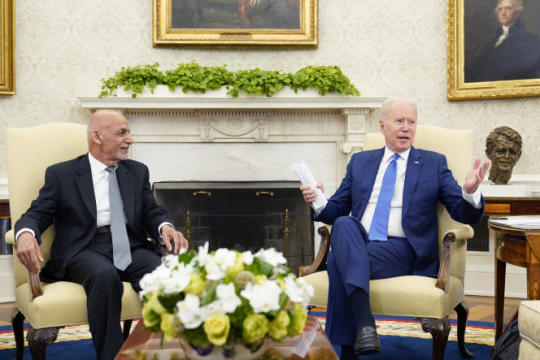
I’m sure like everyone else I wasn’t too surprised by President Biden’s announcement that he was announcing the imminent withdrawal of all American troops in Afghanistan. He wanted to pivot to something else when asked about it. “I want to talk about happy things, man!” He said. Who could begrudge him given that America has been at war in Afghanistan for a better part of 20 years and has nothing to really show for it. Except of course the loss of its brave service men and women as well as the death of thousands of Afghan civilians. It spent more than $2 trillion to kill Osama bin Laden, the architect behind 9/11 attacks and failed to convincingly snuff out both murderous terror groups, Al Qaeda and ISIS.
When the Secretary General of Nato announced back in April 2021 all alliance troops were to be withdrawn from Afghanistan, it was made to look like a nice, clean, enunciation of a joint decision. The end date was set for 11 September, 2021 - 20 years after the terrorist attacks on New York and Washington - and it was in line with the oft-repeated alliance maxim: we went in together; we will come out together. Except that, on closer examination, it was all rather messier.
This was partly because the withdrawal from Afghanistan had actually been Trump’s policy, so here was Joe Biden, the anti-Trump, co-opting a policy from his predecessor (a policy Trump had been so keen on that he tried to accelerate the withdrawal after he lost the election). Biden then tried to detach it from Trump by slowing down the withdrawal date a little and expressing it in terms more comprehensible to the Washington establishment and to US allies.
Where Trump had essentially done a deal with the Taliban and set a withdrawal date of 1 May, Biden left the Taliban out of it and invoked the totemic date of 9/11. This does not mean, of course, that the withdrawal will not be completed a good deal sooner - once you announce a withdrawal, you might as well get on with it.
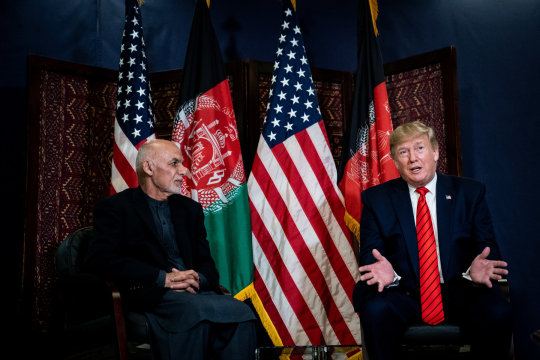
In fact, Biden had to make a decision one way or another, given the rapid approach of Trump’s 1 May withdrawal date. And, whether it came from Washington or Nato, it was pretty low key for an announcement that a 20-year military involvement that had cost 4,000 allied lives was ending. Indeed, many people beyond Washington and Afghanistan might not quite have registered the news, given the considerable noises from Nato’s simultaneous dire warnings about Russia massing troops on the Ukrainian border, the death of the Duke of Edinburgh in the UK, and the Covid pandemic everywhere.
And distractions were needed not just because Biden was implementing a Trump policy. It was also because he was ordering an unconditional withdrawal – which he justified, correctly, by saying that setting preconditions would mean that the troops could be there forever. It was a risk Biden knew all too well, given that Barack Obama had been persuaded by General David Petraeus – against his election pledges and his better judgement – that what Obama really wanted was not a withdrawal, but a ‘surge’ with conditions attached before a withdrawal could take place.
Distractions were also useful for London, where the timing was hardly ideal. Imagine you were in government in London, you had watched the dismal failure of the UK’s Herrick operations in Helmand Province between 2006 and 2014, you knew that your armed forces had suffered 456 deaths in 20 years, with many more severely injured, but you had hung on in there.

Your government had also just released a blueprint for foreign and security policy, setting future priorities even further from home, in the Indo-Pacific, and your Prime Minister was about to make a high-profile visit to India as part of his post-Brexit ‘Global Britain’ branding . In those circumstances, an announcement that the US had decided to leave Afghanistan, giving you no choice but to follow, was almost exactly what you did not need. Rather than showing the UK as a powerful, autonomous military actor and a valued ally, it showed the exact opposite.
It also reminded an unhappy British public about a costly conflict it had rather forgotten. And those who did more than bother to remember - like the families who lost loved ones on the battlefield - and who over the years have blamed successive governments for moving the goalposts and lacking an exit strategy (all true too).
All of which might explain why the UK’s Foreign and Defence Secretaries followed the US example by changing the subject to the iniquities of Russia and China, rather than issuing a joyous pronouncement to the effect of: hooray and thank goodness, our boys and girls are coming home.

The UK’s Chief of Defence Staff, General Sir Nick Carter gave a subdued, unenthusiastic response to Biden’s announcement. I cannot remember such open acknowledgement of UK-US military policy friction in recent decades - or such an abject admission by the UK of its defence dependence on the US. What Carter said was that the unconditional withdrawal was ‘not a decision we had hoped for, but we obviously respect it and it is clearly an acknowledgement of an evolving US strategic posture’. In other words, the UK had opposed Biden’s decision – or would have done, if asked (which is not clear). Also, that it was Washington’s ‘strategic posture’ that had ‘evolved’, not the UK’s. He suggested there was a real danger that progress made could be lost and that there could be a return to civil war, with the Taliban maybe returning to power - again, all true.
Given that the UK officially has only 750 troops in Afghanistan at present, and most of them are there in a training capacity, to dissent from the US position so openly would be considered decidedly rude in the Ministry of Defence. Perhaps to that end, General Carter played the dutiful soldier and had to - through gritted teeth - put a positive gloss on Afghanistan’s future, insisting that the objective in going into Afghanistan, ‘to prevent international terrorism emerging from the country’, had been achieved which was ‘great tribute to the work of British forces and their allies’.
He also said that Afghan forces were ‘much better trained than one might imagine’ and that the Taliban ‘is not the organisation it once was’, so that ‘a scenario could play out that is actually not quite as bad as perhaps some of the naysayers are predicting.’ Blah blah blah. He’s wrong, and I think he knows it but only in the sanctity of his gentlemen’s club might he truly admit it.

I know he’s wrong because the chatter amongst ex-veterans I know is that we’ve made a balls up of Afghanistan yet again - by ‘again’ I mean from the past 200 years of us Brits trying to bring order to chaos in Afghanistan and getting burned for our troubles.
Both my father and my older siblings tell me what their friends and ex-service peers (some very senior indeed) have been nattering over a drink at their gentlemen clubs where ex-veterans haunt the club bar. Many just shake their heads in sighed resignation before burying themselves in the Times crossword or drowning their sorrows with a beer or two at how lock in step we’ve become to the Americans at a time when the British army is re-branding itself as a more independent nimble hi-tech impact army (the creation of a new ranger regiment being but one example).
Still if President Biden wanted to tie a neat bow on U.S. involvement in Afghanistan - saying, as he had, that the logic for the war ended once al-Qaida was gutted and Osama bin Laden killed - then it reveals a stunning lack of introspection about the United States’ role in the conflict that will continue in Afghanistan long after the last American and British troops leave.
Less than three months after President Joe Biden declared that the last American troops would be out of Afghanistan by September 11th, the withdrawal is nearly complete. The departure from Bagram air base, an hour’s drive north of the capital, Kabul, in effect marked the end of America’s 20-year war. But that does not mean the end of the war in Afghanistan. If anything, it is only going to get worse.

It is true that the president had no good choice on Afghanistan, and that he inherited a bad deal from his predecessor. There are never good choices when it comes to Afghanistan: only bloody trade offs.
But in announcing an unconditional withdrawal, he made the situation worse by throwing out the minimal conditions U.S. Special Envoy Zalmay Khalilzad had negotiated under the Trump administration. U.S. envoy Zalmay Khalilzad has delivered to the Afghan government and Taliban a draft Afghanistan Peace Agreement - the central idea of which is replacing the elected Afghan government with a so-called transitional one that would include the Taliban and then negotiate among its members the future permanent system of government. Crucial blank spaces in the draft include the exact share of power for each of the warring sides and which side would control security institutions.
The refrain now from the Biden administration is that the United States is not abandoning Afghanistan, that it will aim to do right by Afghan women and girls, and that it will try to nudge the Taliban and Kabul toward a peace deal using a diplomatic tool kit.
But the narrative ignores much of the reality on the ground. It also ignores history.
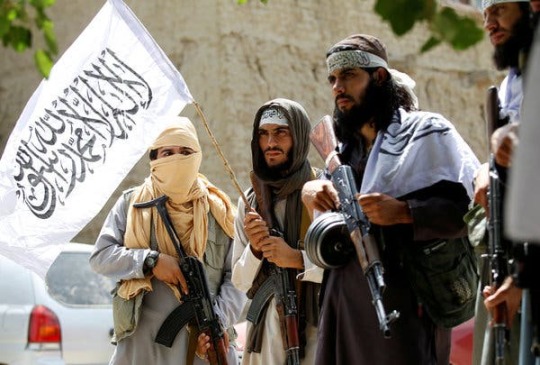
In theory, the Taliban and the American-backed government had been negotiating a peace accord, whereby the insurgents lay down their arms and participate instead in a redesigned political system. In the best-case scenario, strong American support for the government, both financial and military (in the form of continuing air strikes on the Taliban), coupled with immense pressure on the insurgents’ friends, such as Pakistan, might succeed in producing some form of power-sharing agreement.
But even if that were to happen - and the chances are low - it would be a depressing spectacle. The Taliban would insist on moving backwards in the direction of the brutal theocracy they imposed during their previous stint in power, when they confined women to their homes, stopped girls from going to school and meted out harsh punishments for sins such as wearing the wrong clothes or listening to the wrong music.
More likely than any deal, however, is that the Taliban try to use their victories on the battlefield to topple the government by force. They have already overrun much of the countryside, with government units mostly restricted to cities and towns. Demoralised government troops are abandoning their posts. In the first week of July 2021, over 1,000 of them fled from the north-eastern province of Badakhshan to neighbouring Tajikistan. The Taliban have not yet managed to capture and hold any cities, and may lack the manpower to do so in lots of places at once. They may prefer to throttle the government slowly rather than attack it head on. But the momentum is clearly on their side.
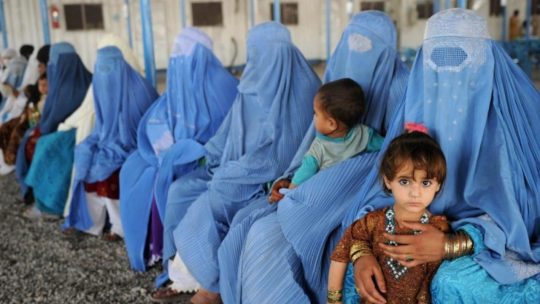
America and its NATO allies have spent billions of dollars training and equipping Afghan security forces in the hope that they would one day be able to stand alone. Instead, they started buckling even before America left. Many districts are being taken not by force, but are simply handed over. Soldiers and policemen have surrendered in droves, leaving piles of American-purchased arms and ammunition and fleets of vehicles. Even as the last American troops were leaving Bagram over the weekend of July 3rd, more than 1,000 Afghan soldiers were busy fleeing across the border into neighbouring Tajikistan as they sought to escape a Taliban assault.
As the outlook for the army and for civilians looks increasingly desperate, so do the measures proposed by the government. Ashraf Ghani, the president, is trying to mobilise militias to shore up the flimsy army. He has turned for help to figures such as Atta Mohammad Noor, who rose to power as an anti-Soviet and anti-Taliban commander and is now a potentate and businessman in Balkh province. “No matter what, we will defend our cities and the dignity of our people,” said Mr Noor in his gilded reception hall in Mazar-i-Sharif, the key to holding the north (sounds like Game of Thrones). The thinking is that such a mobilisation would be a temporary measure to give the army breathing space and allow it to regroup and the new forces would co-ordinate with government troops to push back hard on the Taliban.

However this is Afghanistan. The prospect of unleashing warlords’ private armies fills many Afghans with dread, reminding them of the anarchy of the 1990s. Such militias, raised along ethnic lines, tended to turn on each other and the general population.
With America gone and Afghan forces melting away, the Taliban fancy their prospects. They show little sign of engaging in serious negotiations with Mr Ghani’s administration. Yet they control no major towns or cities. Sewing up the countryside puts pressure on the urban centres, but the Taliban may be in no hurry to force the issue. They generally lack heavy weapons. They may also lack the numbers to take a city against sustained resistance. On July 7th they failed to capture Qala-e-Naw, a small town. Besides, controlling a city would bring fresh headaches. They are not good at providing government services.
Perhaps the Taliban have learned their history lesson and might refrain from attacking Kabul this time around. Their best course may be to tighten the screws and wait for the government to buckle. American predictions of its fate are getting gloomier. Intelligence agencies think Mr Ghani’s government could collapse within six months, according to the Wall Street Journal. So clearly the momentum is on the side of the Taliban and they just need to chip away at Ghani’s forces one district after another until the inevitable and hateful surrender of the central Afghan government to their demands.
At the very least, the civil war is likely to intensify, as the Taliban press their advantage and the government fights for its life. Other countries - China, India, Iran, Russia and Pakistan - will seek to fill the vacuum left by America. Some will funnel money and weapons to friendly warlords. The result will be yet more bloodshed and destruction, in a country that has suffered constant warfare for more than 40 years. Those who worry about possible reprisals against the locals who worked as translators for the Americans are missing the big picture: America, Britain and other allies are abandoning an entire country of almost 40m people to a grisly fate.

Nothing exemplifies - at least in Afghan eyes - of all that has gone wrong with American involvement in Afghanistan than in the manner of their leaving.
The U.S. left Afghanistan's Bagram Airfield after nearly 20 years by shutting off the electricity and slipping away in the night without notifying the base's new Afghan commander, who discovered the Americans' departure more than two hours after they left in the middle of the night without raising any alarms.
They left behind 3.5 million items, including tens of thousands of bottles of water, energy drinks and military MRE's (Meals Ready to Eat ration packs to the uninitiated). Thousands of civilian vehicles were left, many without keys to start them, and hundreds of armoured vehicles. The Americans also left small weapons and ammunition, but the departing US troops took heavy weapons with them. Ammunition for weapons not left for the Afghan military was blown up.
Now that is some feat considering the logistics of this mass exodus without drawing any attention. You have obviously been to Bagram and so you will know just how big and sprawling it is. Bagram Airfield is the size of a small city, roadways weaving through barracks and past hangar-like buildings. There are two runways and more than 100 parking spots for fighter jets known as revetments. One of the two runways is 12,000 feet long and was built in 2006. There's a passenger lounge, a 50-bed hospital and giant hangar-size tents filled with furniture. And all those shops to remind Americans of home from familiar fast food restaurants and hairdressers and massage parlours to buying clothing and jewellery and buying a Harley Davidson motorbike (or so I’ve been told).
I’m guessing that the Afghans were certainly outside of the wire and probably had not been inside Bagram Airfield for months. So from the outset they would not have had any reason to think anything was going on until the generators probably ran out of fuel and it started to go a little too quiet. The inner gate was probably discretely left unlocked and when the US stopped answering the radio/phone and then they probably investigated.
Before the Afghan army could take control of the airfield about an hour's drive from the Afghan capital, Kabul, it was invaded by a small army of looters, who ransacked barrack after barrack and rummaged through giant storage tents before being evicted, according to Afghan troops. Afghan military leaders insist the Afghan National Security and Defense Force could hold on to the heavily fortified base despite a string of Taliban wins on the battlefield. The airfield includes a prison with about 5,000 prisoners, many of them allegedly Taliban members.
I’m pretty sure some bright spark in the US Pentagon public affairs dept convinced his military superiors that it was important to avoid the optics of Americans leaving in the same way they did in Vietnam in case it depresses the American public and the US military. Instead it demoralised its allies, the Afghan national army who are now the only line of defence against the Taliban. In one night, they lost all the goodwill of 20 years by leaving the way they did, in the night, without telling the Afghan soldiers who were outside patrolling the area. The manner in which the Americans left Bagram air base amounts to a resounding vote of no confidence in Afghanistan’s future. It just looks bad.

The U.S. choice came with costs attached to each decision. With staying, the cost was potential U.S. troop casualties and a fear that things would not change on the ground. With leaving comes the cost of a deeper conflict in Afghanistan and a backsliding of progress made there over the past two decades. In many ways, the costs of staying seem shorter-term and borne by the United States, while the costs of leaving will be predominantly borne by Afghans over a longer time horizon. Yet, even if those costs seem remote now, history tells us that they will be blamed on the United States.
Biden perhaps reflective of history of Americans getting into quagmires abroad didn’t want to be seen exerting time and energy for a losing cause. His decision also reflects his administration’s foreign policy for the American middle-class paradigm, which focuses on domestic considerations over international ones (and is this so different from Trump’s “America First”? No, it is not). The irony, though, is that the American middle class largely doesn’t care about Afghanistan - their ambivalence gave way to support for this decision once it was announced, but it wouldn’t be hard to visualise the public approving of a scenario that kept a couple thousand troops there for a while longer.

What’s perhaps most disturbing is the narrative the president has presented along with the rationale for withdrawal: that America went to Afghanistan to defeat al-Qaida after 9/11, that mission creep led America to stay on too long and, therefore, it is time to get out. This takes an incomplete view of U.S. agency in the war in Afghanistan. The narrative implies that the civil conflict in Afghanistan today did not originate with America - that this more than 40-year war began with the Soviet invasion of Afghanistan in 1979, preceded America’s interference in Afghanistan, and will follow our departure.
The fact of the matter is that, by beginning the campaign in Afghanistan in 2001 and overthrowing the Taliban, who were then engaged in their draconian rule, and installing a new government, we western allies began a new phase of the Afghan conflict — one that pitted the Kabul government and the United States/Britain/NATO against the Taliban insurgency. The Afghan people did not have a say in the matter. That we allied powers are leaving Afghan women, children, and youth better off in many ways after 20 years is due to us, and we should be proud of that. But that we are leaving them mired in a bloody conflict is also due to us, because we could not hold off the Taliban insurgency, and we must all reckon publicly with that.
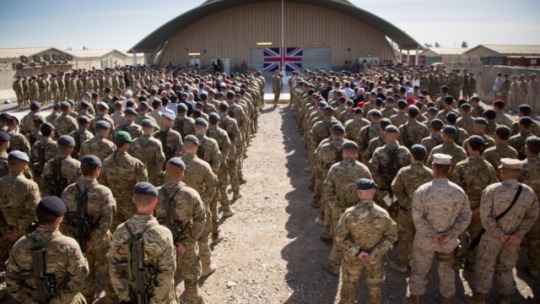
I have to ask myself why did we fail?
I’m only speaking about us Brits now as I’m sure you have your own thoughts as an ex-Marine officer of what you thought of the American military effort. Yes, I’m copping out of really bashing the yanks because first, I have too much respect for those fantastic American service men and women I did have the privilege to fight alongside with; and second, we Brits have nothing to crow about as we fucked up in lots of ways too, and to make things worse, we should have known better given our imperial history with Afghanistan.
The seeds of our failure in Afghanistan lies in not learning from history. We didn’t have a mission that was properly defined nor did we have a strategy that was clear, coherent, and easily communicated to both its fighting men and women as well as to the British public.
Were we there to get our hands bloody and to root out and destroy extreme Islamist terrorists or were we there to indulge in state building out of some idealistic notions of liberal humanitarianism? This question was at heart of our failure within our government and also within the British army as well as our relations with America and our NATO allies and finally the Afghans themselves.
Although never colonised in the same manner as other central and south Asian countries, the modern Afghan state is very much a creation borne out of great power rivalry. A land occupied by a number of different ethnic, linguistic and religious groups, it is a country whose borders were defined by, and whose sense of national identity was forged in response to western great power competition. Its geopolitical position - landlocked, mountainous, and surrounded by past great powers and present regional rivals - lends Afghanistan a dual role of geographic obscurity and great strategic significance, and has as such frequently been treated as little more than a buffer state between empires and a proxy of local powers. Its shared historical border with Russia and British India made it an object of imperial intrigue and, by consequence, has been subject to five European military interventions in the last 175 years.
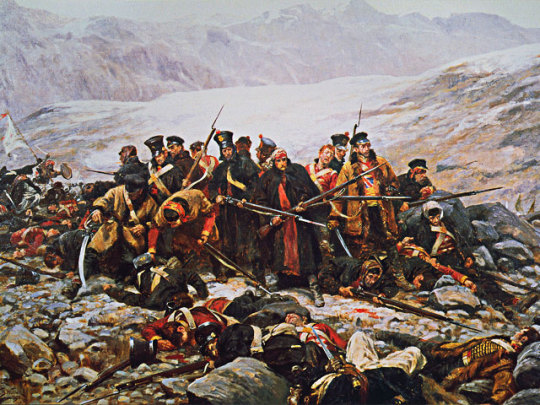
The first three interventions of these occurred during the era of ‘the Great Game’ in the nineteenth and early twentieth centuries, in which Britain and Russia (latterly the Soviet Union) competed for influence and control over Afghan politics in order to protect their respective imperial holdings in India and central Asia.
The fourth and fifth interventions, ranging from the late 1970s to the present day, similarly involved attempts by Soviets and then by an American-led international coalition to remove political leaders acting against their interests and to protect their favoured candidates.
The unifying feature of all these conflicts was the idea of Afghanistan as the site of potential threats to the interests and security of more powerful states.
Britain’s legacy in Afghanistan in particular set the tone for the country’s historical pattern of conflict and political contestation, fuelling both the intermittent emergence of Afghan national consciousness and a fractious political lineage that saw thirteen amirs in just eighty years. Interventions by the Empire during the Great Game set the conditions for the assassination of ostensibly national leaders by their compatriots (Shah Shuja Durrani in the First war) or their exile by the British (Shere Ali Khan and Ayub Khan in the Second).
Despite the British achieving their aim of protecting India in the second and third conflicts by maintaining Afghanistan as either a pro-British buffer state or as a neutral party, the Afghan narrative tends to emphasise successes such as the massacre of British forces retreating from Kabul to Jalalabad in 1842, the defeat of British and Indian forces at Maiwand in 1880, and the gaining of sovereignty in foreign affairs in 1919.
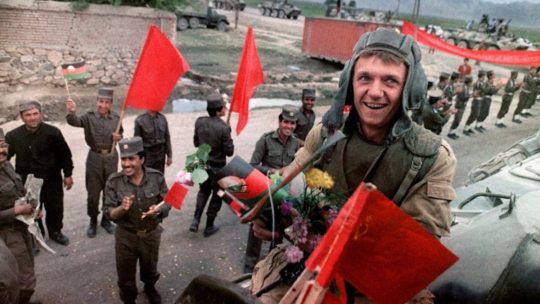
Soviet intervention in the late 1970s and 1980s further buttressed this identity of resistance, and the failure and ultimate overthrow of the Communist-backed Najibullah government, as well as the collapse of the Soviet Union shortly after their drawdown from Afghanistan, led to a sense amongst the victorious mujahidin of the country as the ‘graveyard of empires’.
Afghanistan’s modern history should thus be seen as inextricably linked to the ebbs and flows of great power politics. Each intervention exacerbated extant internal power struggles between rival elite individuals and groups vying for nominal control over the country. Foreign intervention in Afghanistan was met on each occasion with fierce resistance from tribal militias coalesced around religion; as has been remarked upon by one historian of the country, the threat of external domination has been one of the few means of uniting its disparate population around the concept of an Afghan ‘nation’, and in most cases this shared sense of identity cohered around religion, not nationalism.
Indeed, the presence of intervening powers and the development of the Afghan state may be seen as mutually supporting: whilst most Afghan leaders throughout the last two centuries have asserted their sovereignty over the country, the reality has in most circumstances been one of competing tribal chiefs and/or ‘warlords’ rather than a single dominant leader.
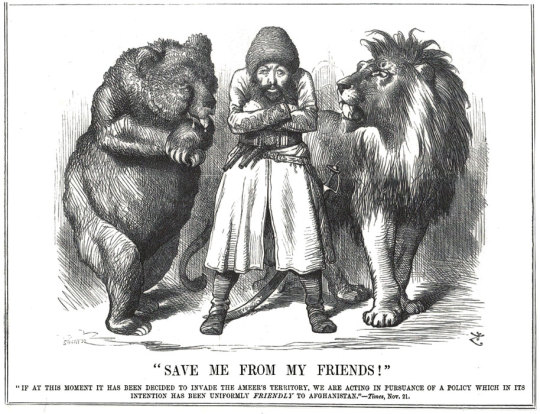
Where leaders have managed to cohere the disparate tribal and ethnic groupings of the country under one banner - most notably under the regime of Dost Mohamed Khan (1826-1839, 1845-1863) – this was due in large part to their diplomatic abilities of compromise and co-optation with Afghanistan’s regional power- brokers. In other cases, such as that of the reign of Abdurrahman (1880- 1901), power was maintained by an unflinching ‘internal imperialism’ and the use of punitive force against rebellious factions.
The challenges of maintaining and projecting centralised power in Afghanistan allow us to see the relationship of its leaders with world or regional powers in the last two centuries as one of mutual exploitation. Throughout the Great Game and the Cold War, whilst the British/Americans and Russians/Soviets would use threats and bribes (and occasionally force) to compel Afghan rulers to comply with their geopolitical needs, Afghan rulers themselves often deftly manipulated those powers to maintain and extend their own power.
The pattern followed by Afghan leaders from the nineteenth century to the present day is remarkably similar in the respect that most have relied upon a rentierist economic model, seeking external aid in order to sustain the cost of security and administration. The plan of modern rulers was to warm Afghanistan with the heat generated by the great power conflicts without getting drawn into them directly. Abdurrahman, for example, used British subsidies to fund his military campaigns against rebellious factions; the Musahiban rulers of the mid-twentieth century used American capital to develop its nascent economic infrastructure and Soviet finance to bolster its armed forces; and, following the overthrow of the last royal leader of Afghanistan, Mohamed Daoud, in 1978, the quasi-communist leadership of Babrak Karmal, Hafizullah Amin, Nur Muhammad Taraki, and Mohammad Najibullah during the late 1970s and 1980s relied in the main on Soviet money and military assistance in its ultimately failed attempt to implement socialist policies and put down the American, Saudi and Pakistani-backed mujahidin.
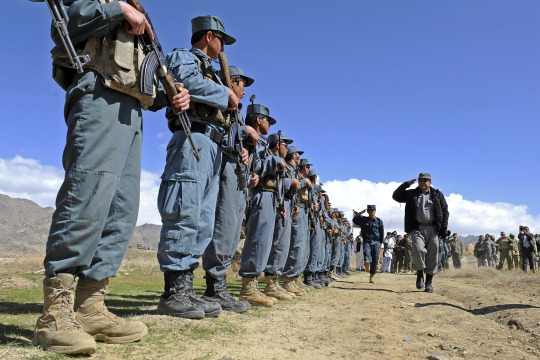
These trends continued into the post-Cold War period in respect to both the Taliban movement (essentially directed and funded by Pakistan), the Northern Alliance (funded largely by former Soviet central Asian states) and the regime of Hamid Karzai (maintained in economic and military terms by the American-led, NATO-operated International Security Assistance Force and the wider international community). In the former cases, occurring in the main in the period of civil war between 1992 and 2001, rentierism was limited to the maintenance of proxy parties and the continuation of conflict.
By contrast, the ISAF mission bore similarities with the Soviet-backed socialist regimes of the 1980s, insofar as it focused huge amounts of capital and military resources on stabilisation and state-building efforts. Both intervening parties made the error of ignoring Afghanistan’s political history and focused their efforts on bolstering the authority of a centralised state, both promoted policies that were deemed ‘universal’ in their application and were, unsurprisingly given such hubris, vulnerable to accusations by Afghan opposition to being alien and imperialistic ideologies, and both expended enormous amounts of blood and treasure in order to sustain the regimes they supported.

The UK’s struggle to locate a coherent strategy for Afghanistan should, therefore, be seen firstly in the light of the historical problematic of Afghan state-building. This is important in narrative terms because difficulties of defining strategy imply similar challenges in explaining strategy. As with its efforts to ‘think’ strategically, Britain’s ability to explain the strategy(ies) for the war in Afghanistan have been frequently criticised by various commentators. The most strategically debilitating aspect of the Afghan campaign has always been the incoherence of the mission’s purpose; indeed the question ‘‘why are we in Afghanistan?’’ has never really been settled in public consciousness.
The international community massively underestimated the difficulties of state-building and greatly overstretched themselves in the commitments made to Afghanistan, and that they did so because ‘strategies’ for Afghanistan rested on assumptions of the universal applicability of liberal state-building.
The international community from the start (meaning from the Bonn Conference of late 2001) fundamentally misunderstood the nature of an Afghan society deeply ravaged by decades of conflict, and failed to foresee the malign effects state-building ventures would have on the country. Specifically, the Bonn Conference, which set out the parameters of the post-invasion Afghan state, implemented a centralised state system onto a state whose experience of such was limited, and where the success of such a system in extending its authority beyond the major cities was predicated on coercion and the use of force.
Historically this has rarely been a credible option for Afghan rulers or their international backers, and was even less so under the self-imposed restrictions of liberal war-fighting and state-building. Rather, re-creating a centralised state required Afghan and international actors to enter into the same methods of co-optation and compromise as those of the past; in necessitating these kind of measures – as opposed to implementing a looser, federal system of governance – the centralisation of the Afghan state paved the way for a reconstitution of a ruling order based on tribal elements and ‘strongmen’. This produced something of a paradox for state-builders, as the creation of a strong, central state capable of implementing liberal policies across Afghanistan came at the cost of entering into alliances with ‘warlords’ known for their illiberal and coercive political approaches and illicit economic activities.

Another unintended but unavoidable consequence of centralised state-building identified by scholars is the re-constitution of the rentier state in Afghanistan. Post-Bonn, Afghanistan returned to its historical norm of maintaining the state via the extraction of external security and development rents, without which it would almost certainly implode due to the ruinous state of its economy and taxation system. Studies have shown that his new rentierism differed from previous patronage systems at the state level insofar as it was fuelled by an unprecedented influx of capital and resources into the country. This had the effect of introducing regulated systems of ‘neo-patrimonalism’, where departments were to be distributed as rewards to the various factions that took part in the Bonn conference, and there had to be enough rewards to go around.
In other words, the structure of the post-invasion Afghan state was, to a great extent, defined not by the demands of good governance, the needs of the country or the demands of post-conflict stabilisation and reconstruction – the purposes for which the centralised model was chosen to promote – but rather by the first-order need to avoid the derailment of the centralised state by co-opting regional power brokers.
Because of the imperative of shoring up a nascent state by securing support from potential competitors, the gulf between the ends of liberal state-building and the illiberal means required to facilitate its functioning can therefore be seen to a certain extent as inevitable.
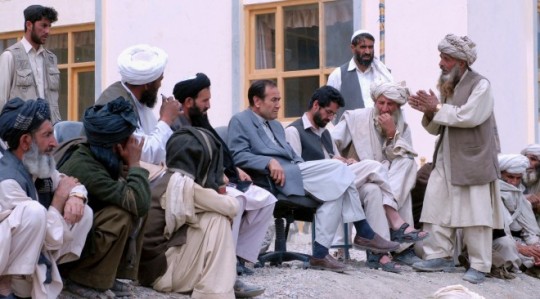
A major issue, however, was that the patrimonial linkages created by the state for its regional proxies was not comprehensive, as it did not extend to the Taliban’s Pashtun heartland and, as such, fuelled resentment and alienation as much as they placated and co- opted extra-state power brokers. Key players in the Northern Alliance - the primarily Tajik opposition to the Taliban - received prestigious posts within the state, whilst the predominantly Pashtun Taliban were themselves excluded from such arrangements. Because those rewarded by the state tended to be given ministerial or governorial roles in cities, the conflict dynamic tended to reflect an urban – rural divide similar to that of the Soviet occupation. Along this reading, the neo-Taliban insurgency was in many ways a product of the political miscalculations and deficiencies of post-invasion state- building activities.
Given this starting point, such a view concludes that the strategic problems encountered by the international community in Afghanistan were, to a large degree, problems created by (or at the very least exacerbated by) the state-builders themselves. They misread Afghan politics in a way that reflected their own philosophical assumptions about the state and society.
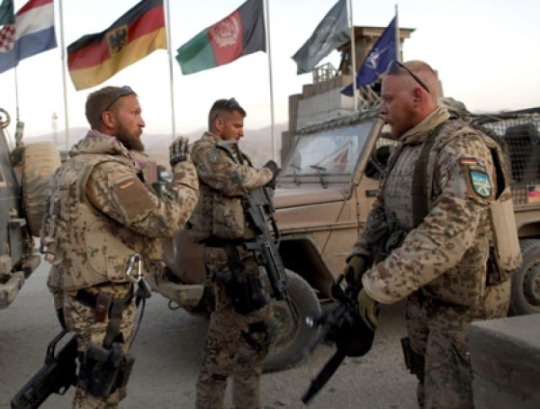
Strategy in Afghanistan suffered because the coalition effort, comprised of multiple national actors and the United Nations, rarely took on the form of a unified effort. Part of the reason for this was a divergence of opinion between actors as to the ultimate purpose – counter-terrorism or state-building – of the intervention.
In the first years of the Afghan campaign, the United States’ Bush Administration remained staunchly opposed to what it called ‘nation building’ and opted instead to pursue a policy of capture- or-kill missions against suspected terrorists. For the United Nations and most of the United States’ European NATO allies, however, state-building was considered a necessary element of any counter-terrorist strategy. This difference of opinion was manifest from the start by the creation of two parallel missions – the US-led, counter-terrorism-focused Operation Enduring Freedom (OEF) and the stabilisation missions of the European Union, United Nations (United Nations Assistance Mission in Afghanistan (UNAMA)) and NATO (International Security Assistance Force (ISAF)) – engaged in seemingly incompatible aims of military prosecution and peace building.
Opinion on the impact of this dual approach varies. Some scholars have noted, along lines similar to those critiquing the state-building efforts of the international community that the approach taken by the UN, EU and ISAF was too ambitious, naïve and unrealistic, and therefore bound to fall short of their liberal political and economic goals. Both Europe and these international agencies ignored the necessity of paring down the international community’s state-building efforts to core, security-centric capacity building within the Afghan National Security Forces. But of course one can make the counter argument, as many have of course, that on the contrary it was the insufficiencies of state-building approaches vis-à-vis OEF’s counter-terrorist approach that led to subsequent failures in UN and ISAF efforts; specifically, that a disproportionate focus on counter-terrorism missions meant that opportunities of peace- building were irreparably compromised.
Within NATO there was a division not just of opinions but also one of mission relating to different political perspectives about the purpose of the Afghan mission and its ultimate referent object – whether it was primarily about the interests of the coalition member states or concerned in the main with Afghanistan itself – and, from that, the methods to be employed in pursuit of one or another objective. This was not merely a debate bounded by strategic necessity, however; rather, such debates stemmed as much from institutional disagreements over who would or could do what in Afghanistan, which in turn arose from the differences in political constitutions and cultural attitudes towards counterinsurgency and counter- terrorism.
These ‘national caveats’ or ‘red cards’ of participation created significant problems for NATO in Afghanistan, both political, in terms of the relations between states and the abiding sense amongst some that others were ‘free-riding’ on the collective security system and, and strategic and operational, in the sense that command-and-control capabilities and cohesion between forces were limited by the engagement restrictions placed on certain armed forces. Indeed, the disproportionate burden placed on combat-oriented states like the United States, the United Kingdom, and several new member states in Eastern Europe led to political statements denouncing Europe’s perceived transgressors of collective security participation; former US Defence Secretary Robert Gates argued, for example, that NATO had effectively become a ‘two-tier alliance’ ‘between members who specialise in ‘soft’ humanitarian, development, peacekeeping and talking tasks and those conducting the ‘hard’ combat missions - between those willing and able to pay the price and bear the burdens of alliance commitments, and those who enjoy the benefits of NATO membership... but don’t want to share the risks and the costs’.
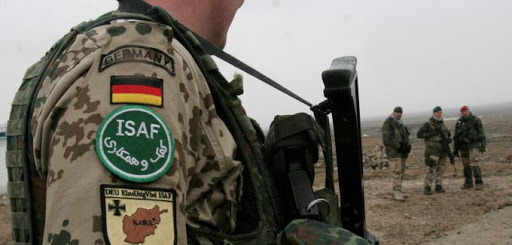
A lack of strategic unity was the natural consequence of a structural compromise that produced two distinct strategic authorities that were, in many ways, competing with one another. Along similar lines to the political arrangements between the Afghan state and its regional proxies, the NATO alliance structure can be seen (and evidently is seen by officials such as Gates) as patrimonial: states participated on the basis of fulfilling their own interests and along operational lines that were complementary to those interests, for the purposes of securing an alliance structure that accommodated all participants ahead of the imperative of creating a coherent strategy for stabilising Afghanistan. As with the neo-patrimonialism of the Karzai regime NATO’s efforts would be dictated by the limitations imposed upon it by circumstance.
Thus, in the cases of Afghanistan’s and the international community’s internal political dynamics, strategy was confined by the structure of the Afghan state and society, the structure of the international community and NATO, and the interplay between those structures. The implication here is that the agency required for the possibility of a workable strategy may have been illusory from the start.
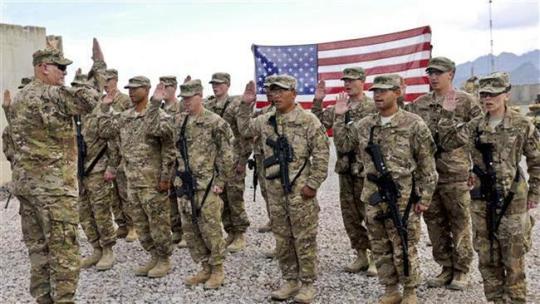
Leaving Afghanistan was never going to be pretty, but the latest turn is uglier than expected.
No one quite expected the speed of collapse within the Afghan National Army to hold of attacks of the Taliban. I don’t think it’s do with the lack of training or their professional skills is lacking (though there may be some truth in it). A big driver in the collapse is the money for wages, food and medical care for troops is syphoned to Dubai, so the Afghans who want to fight, and there are quite a few who hate the Taliban, get less replenishment than the 6th army in the last weeks of Stalingrad. They have arms, ammo and boots for this season only and that is it. Both money and morale are in short supply for these soldiers.
If I was a trained soldier in the Afghan National Army I would desert. I would say to them abandon the fixed defences these ‘ferenghis’ (foreigners) have gifted you and move to the hills and seek refuge with your tribal clan, who will be glad of the arms and experience you bring. Or get over the border if you are lucky to be in the North, if in the West you hire yourself to the Narcos in the badlands on the Iran border. Most other places it is either a last stand or defection, your Government and their relatives have already got their planes fuelled up in Kabul ready to move to their villa complexes in the UAE.
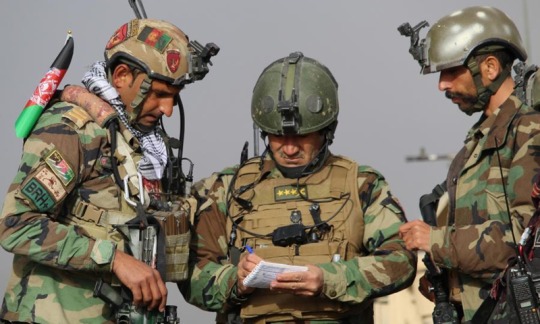
I’m being a trifle cynical but for good reason. Everyone who has been to Afghanistan sees the veil lifted on the corruption of aid and how the elites protect themselves ahead of defending the masses who bear the brunt of the bloodshed.
The corruption has been endemic from the get go, but the international community ignored it all for 'progress'. Any Afghan politico you hear on the media complaining about the West abandoning Afghanistan has at least $30 million parked in Dubai that should have gone to the soldiers, teachers, doctors, builders etc.
As spectacular as the collapse of the Afghan National Army has been it’s been even more scarier seeing how swift the Taliban has been in taking over vital provincial areas through propaganda, civilian intimidation, and rapid attacks. One by one, the Taliban has been taking over areas in a number of provinces in northern Afghanistan in recent weeks. The Taliban says it has taken control of 90 districts across the country since the middle of May. Some were seized without a single shot fired.
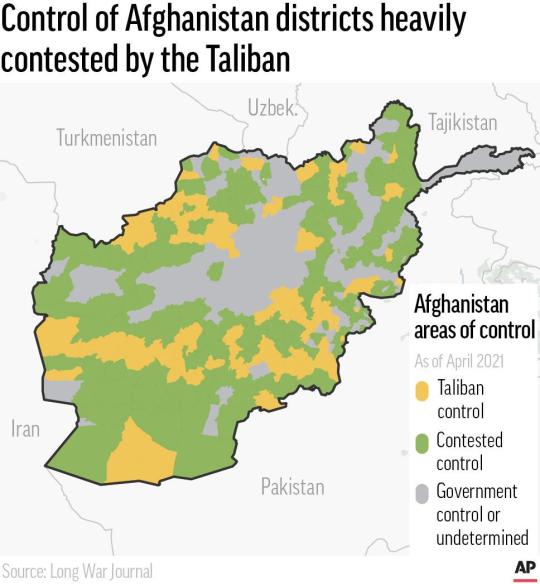
The UN's special envoy on Afghanistan, Deborah Lyon put the figure lower, at 50 out of the nation's 370 districts, but feared the worst was yet to come. Most districts that have been taken surround provincial capitals, suggesting that the Taliban are positioning themselves to try and take these capitals once all foreign forces are fully withdrawn. On a map, it's easy to see the point Lyon is making. A stark example is Mazar-i-Sharif, the biggest city in the north and a significant power centre in its own right. It was the rock upon which the Northern Alliance fought against the Taliban.
It is significant the Taliban are kicking off this offensive in the north, not their heartland in the south and east. The north was the toughest part of the country for them to crack last time. Their expectation is if they have victory there, success will flow much easier in their traditional homelands further south.
The strategy of taming the north extends to emasculating and profiting from trade routes to neighbours. On Monday night they captured the important border town of Shir Khan Bandar, Afghanistan's main crossing into Tajikistan. Earlier in the day, top Tajik government officials had met to discuss concerns about the growing instability next door. There is no indication that the Taliban intend to take their fight north of the border, but in the past Tajikistan has been a vital conduit for supplies flowing to the militants' northern enemies.
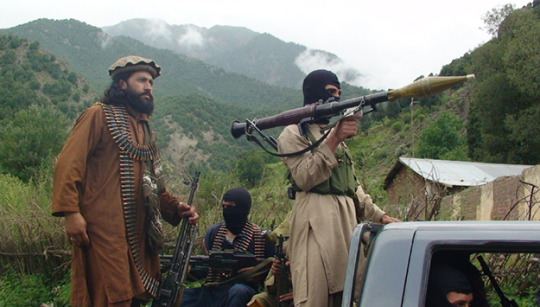
The last time the Taliban controlled the city was 20 years ago, when they left hundreds of captives in steel trucking containers to suffocate and die in the scorching desert heat. Now, the militants are back at the city gates once again, as part of a lightning offensive against Afghan government forces that has set alarm bells ringing from Kabul to Washington. So it should worry us all where will all this lead to.
America's drawdown seems to be the game changer. The Taliban have been beaten back several times in recent years, notably from Kunduz in 2015. The Taliban captured it briefly before US airstrikes were called in. Civilian casualties were high but the militants were driven out. The militant group has never been able to withstand the heavy US and NATO air assaults backing Afghan ground forces, but now the US and NATO are leaving, so is much of the threat of sophisticated and sustained air power. And the Taliban are well aware of this.
It seems to me behind the choice of withdrawal by the Biden government lies a bigger assumption that drives that choice. That is the Taliban militants' perceived desire for international recognition. This has been the mantra underpinning the American exit. The logic of the American argument has been simple: The Taliban wouldn't renege on their agreements with the US because they crave international acceptance. The events of this past week and more appear to blow a hole in that assumption.
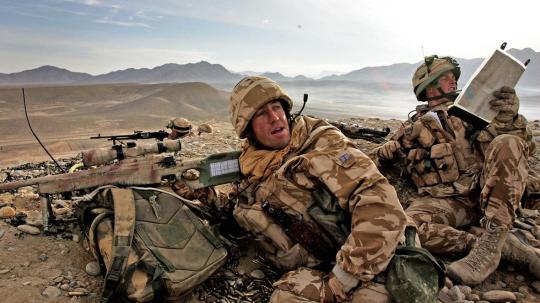
Another assumption that’s currently being blown out of the water is the US establishing some presence outside of Afghanistan so that if it needs to intervene again to combat terrorism or flush out militants then it can do so from the safety of a neighbouring country. But so far no country has come forward to reciprocate. And why would they? Like the Afghans, no one likes foreign troops with boots on the ground in their country. Only the central Asian republics and possibly Pakistan would come close to allowing that but there would be a political cost those governments would pay with their people. Moreover by welcoming the Americans in, they also allow the militants to target that country too.
Another assumption is the nature of the Taliban support and links to terrorist groups. The U.S. may not face any serious post-withdrawal Afghan support of extremist threats to the United States, even if the Taliban does take over. It is all too true that the Taliban continues to talk to the remnants of Al Qaeda, as do elements of the Pakistani military. It is unclear, however, that these remnants of Al Qaeda focus on attacks on the U.S., and the Taliban does seem to oppose ISIS. It is also unclear that the Taliban will host other extremist movements that focus on attacking the U.S. or states outside the region.
It is unclear that any key element of the Taliban has an interest in such attacks on the United States. Even Al Qaeda now focuses largely on objectives inside Islamic countries, and it is unclear that some other major extremist force will emerge in Afghanistan that do not focus on regional threats and on taking over vulnerable, largely Islamic states.
At the same time, one needs to be careful about the assumption that the U.S. can defeat any such threats by launching precision air and missile strikes against extremist targets. It is unclear that the forces in Afghanistan involved in any small covert attacks on the U.S. will be easy to target and cripple if they do emerge. The Taliban is unlikely to tolerate major training camps and facilities for extremist forces, and any such strikes will present major problems for the U.S. if the extremist threat consists of scattered small facilities and small expert cadres that shelter among the Afghan population.
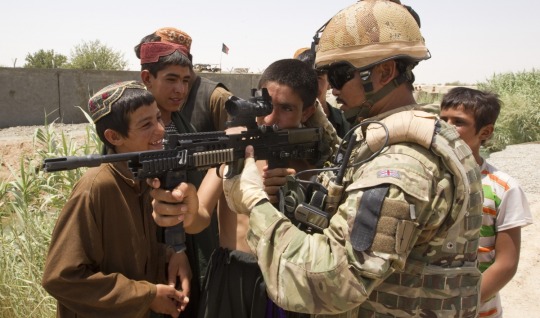
It is also far from clear that more intense U.S. air attacks on Taliban forces from outside Afghanistan will have any decisive effects. The loss of limited numbers of Taliban fighters as well as some key Taliban leaders and facilities will not offset the pace of their victories in the countryside or enable the central government to survive. A continuing U.S. ability to target and kill some key Taliban leaders and fighters also does not mean that the risk of such strikes will deter future Taliban willingness to let small, extremist strike groups conduct well-focused, well-planned strikes on U.S. or allied territory, especially if such groups in Afghanistan sponsor attacks on the U.S. or it strategic partner by strike units or cadres based in other countries.
At the same time, it does seem more likely that the Taliban, and/or any independent extremist groups, will focus largely on Iran, Pakistan, Russia, China, and the other “-Stans.”
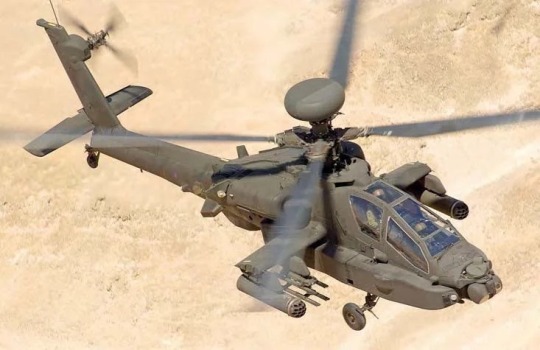
Going forward I think we need to re-evaluate many of our assumptions about the war in Afghanistan.
The objectives of the Authorised Use of Military Force approved by the US Congress in 2001 have long been accomplished. Once Osama bin Laden was killed in Operation Neptune Spear in 2011, the last element of the AUMF was met. The American and British mission in Afghanistan was complete. But America and Britain did not leave because we wanted to do a spot of state building to curb the spread of militant islamist terror. That was a mistake as it turned out.
Post-Neptune Spear, The American, the British, and their allies’ conventional mission should have been ended, adopting instead a laser focus on intelligence collection and offensive special operations to prevent al-Qaeda (or any terrorist organisation) from re-establishing safe havens and training areas.
What was needed for an acceptable ‘victory’ and a ‘saving face’ withdrawal was to embrace the use of Afghan Militia Forces the same way the Allies did for our initial entry way back in 2001.
In 2001, Western powers won the initial military engagement in 42 days using special operations forces with local and regional allies - we need to return to this format - and through a combination of special operations and specific information operations efforts, regaining the high ground and influence over ‘centres of gravity’. The issue is not the number of troops, but the mission of the forces there. Once the mission is defined, the number of forces needed would be clear.
It has never been about the number of troops - it’s been about the lack of an achievable mission assigned to our forces in Afghanistan.
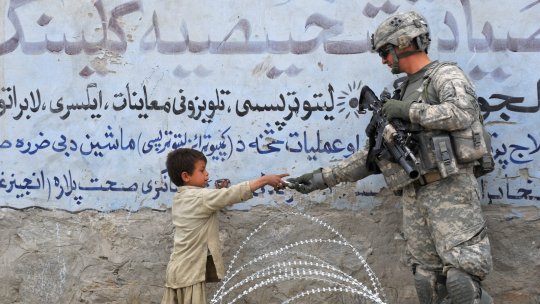
The US engaged in ‘nation-building’ for the wrong reasons - and has seen bad results. We installed Hamid Karzai, served as his praetorian guard to protect the new central government and abandon our AMF allies and attempted to build a large, bulky, expensive and ineffective Afghan National Army - a force that is now evaporating before our eyes. It was folly.
Americans will never make the Afghan people more like them - nor will they be able to instil what my American colleagues used to fondly refer to as ‘a Jeffersonian democracy’ in Afghanistan. That day may come but only when the Afghan people wish it to be so. Lest it be forgotten Americans sought independence in 1776; the Afghan people seek self-reliance and independence from foreign influence. This is their defining historical DNA: escape from any outside control.
The Afghan people are not ungoverned, they are self-governed - with no tradition of central democracy and no desire for our version of democracy or ‘prosperity’. By pushing ‘prosperity’ we had become targets for both the Afghan government and the Taliban. This has ended, but we must draw a distinction between the end of nation-building and the continuation of our own interests in Afghanistan and the region.

It is time to adopt a practical policy based on what will work and is in our allied interests, rather than by funding the aspirations of progressive politicians who have no real understanding of Afghanistan.
First, we must establish a clear post-‘state-building’ strategy - with achievable objectives. We must return to the policy and operational format we know will work - cooperation with Afghan tribal leaders and militia. This type of force was used to achieve the initial victory in 2001. Empowered warlords and regional leaders were the force multiplier that worked as the Afghan Militia Forces - and can again, in partnership with our Special Operations Forces work now. Intelligence collection and limited military operations should be our focus.
There is no way around it. One has to play the Great Game. Think tribal rather than central. Afghan nationhood is a liberal Western wet dream.
The central government is weak and corrupt just like all the other rulers of the past. The Afghan National Army is not as strong as it is on paper. It can hardly prop itself up rather than any government. Most of the Afghan National Army troops have stronger tribal loyalties than to the concept of a nation. Since the tribal chiefs play both sides to hedge their bets, it's no wonder 'their' people do what they're told. The Taliban know this because that has always been the Afghan way, so the tribes go with them. Provided the Taliban honour their promises to the tribal chiefs, the Taliban can do what they want.
On one hand, the tribes won't now be too bothered by central government and have a large pool of Western-trained troops to prop them up. On the other hand, they now have to do business formally with the Taliban again. Largely in order to get their hands on Western-supplied aid that will surely follow after the Americans leave.
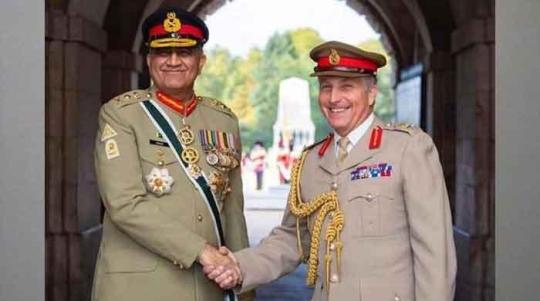
Second, we must accept the reality of Pakistani influence in Afghanistan - and work with the Pakistanis to counter al-Qaeda and the other militants now attacking Pakistani targets within Pakistan. Pakistan has made great advances in securing the tribal areas on the other side of the border and they have always been the de facto control of much of the Taliban force capacity, such as the Haqqani network. Working with Pakistan is the best option within the current circumstance.
‘Endless wars’ are not an American value. The use of the US military must only be used in response to genuine threats, when American interests are at stake or lives in danger. Withdrawal of conventional military forces and discontinuing nation building is in the US interest: leaving Afghanistan is not.
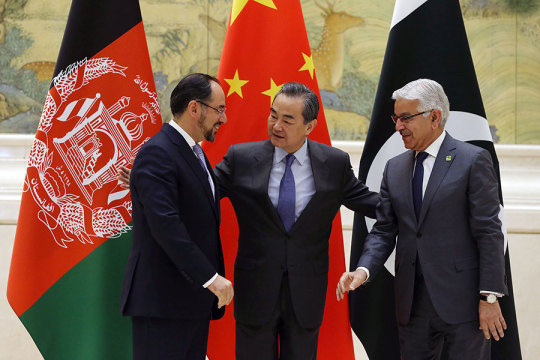
Third, make Afghanistan China’s problem. Afghanistan could easily become a hotbed for growing Islamic extremism, which would to some extent affect stability in Xinjiang.
It is not without reason that Afghanistan is known as the “graveyard of empires”. The ancient Greeks, the Mongols, the Mughals, the British, the Soviet Union and most recently the US have all launched vainglorious invasions that saw their ambitions and the blood of their soldiers drain into the sand. But after each imperial retreat, a new tournament of shadows begins. With the US pulling out of Afghanistan, China is casting an anxious gaze towards its western frontier and pursuing talks with an ascendant Taliban. The burning questions are not only whether the Taliban can fill the power vacuum created by the US withdrawal but also whether China - despite its longstanding policy of “non-interference” - may become the next superpower to try to write a chapter in Afghanistan’s history.
Beijing has held talks with the Taliban and although details of the discussions have been kept secret, government officials, diplomats and analysts from Afghanistan, India, China and the US said that crucial aspects of a broad strategy were taking shape. An Indian government official said China’s approach was to try to rebuild Afghanistan’s shattered infrastructure in co-operation with the Taliban by channelling funds through Pakistan, one of Beijing’s firmest allies in the region. China is Pakistan’s wallet.

It has been reported that Beijing has been insisting that the Taliban limit its ties with groups that it said were made up of Uyghur terrorists in return for such support. The groups, which Beijing refers to as the East Turkestan Islamic Movement, are an essential part of China’s security calculus in the region. The ETIM groups were estimated by the UN Security Council last year to number up to 3,500 fighters, some of whom were based in a part of Afghanistan that borders China. Both the UN and the US designated the ETIM as terrorists in 2002 but Washington dropped its classification last year. China has accused the ETIM of carrying out multiple acts of terrorism in Xinjiang, its north-western frontier region, where Beijing has kept an estimated 1m Uyghur and other minority peoples in internment camps.
In a clear indication of Beijing’s determination to counter the ETIM, Wang Yi, China’s foreign minister, exhorted counterparts from the central Asian states of Kazakhstan, Uzbekistan, Kyrgyzstan, Tajikistan and Turkmenistan this year to co-operate to smash the group. “We should resolutely crack down on the ‘three evil forces’ [of extremism, terrorism and separatism] including the East Turkestan Islamic Movement,” Wang said in May according to Chinese news media which I follow.
The importance of this task derived in part from the need to protect large-scale activities and projects to create a safe Silk Road. Silk Road is one of the terms that Chinese officials use to refer to the Belt and Road Initiative, the signature foreign policy strategy of President Xi Jinping to build infrastructure and win influence overseas.
An important part of China’s motivation in seeking stability in Afghanistan is protecting existing BRI projects in Pakistan and the central Asian states while potentially opening Afghanistan to future investments. China would have to more actively support efforts to ensure political stability in Afghanistan. So make them work for it. Western powers need to leverage China’s problems in Xinjiang to be more active in Afghanistan.
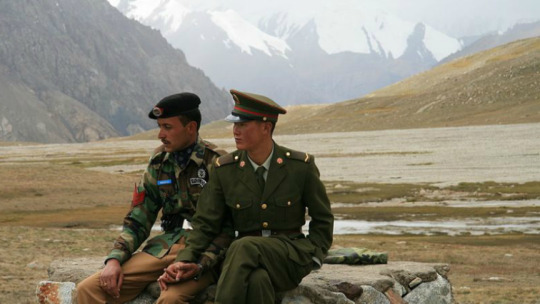
International media outlets and intelligence agencies worldwide have been circulating reports pointing toward the creation of a Chinese military base in the Wakhan Corridor of Afghanistan’s Badakhshan province for a while now. Although China has not embarked on militarisation programs on foreign soil historically, and has profusely denied the rumours about building an Afghan “mountain brigade,” China’s first overseas military base in Djibouti provides an example of China’s newly adopted strategy of leveraging economic influence to further its strategic objectives. There’s even some chatter amongst Chinese officials that Beijing may entertain the idea of being part of a future UN international force should one be needed in Afghanistan (a bad idea but hey, let China find out first hand for itself).
The Afghan government was able to maintain a measure of stability largely because of the superiority of US air support. The drones, gunships, helicopters and heavy air artillery were unmatched by the Taliban. But when the US leaves, that advantage will evaporate. China’s imperative to create overland trade routes to Europe and the Middle East may draw it inevitably into Afghanistan’s domestic strife.
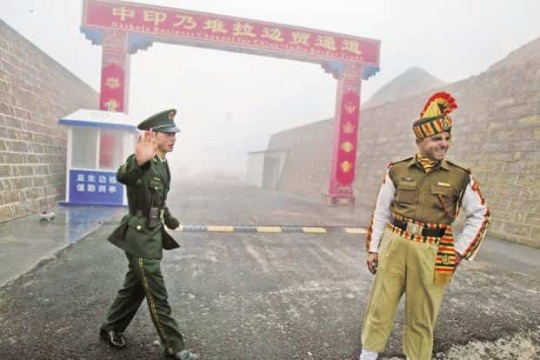
Of course China’s forward policy in the Wakhan Corridor needs to be assessed with a critical eye. Although on one level it seems to be motivated primarily by the threat of radicalisation, China’s interest in the region is also contingent on the strategic role that Afghanistan is capable of playing in the larger scheme of things. Despite China’s vehement denial, there seems to be sufficient evidence available indicating a definite military build up in the region, which provides China with an opportunity to showcase its ability to transform into a balancing force in the regional dynamics. I think that is a trade off that both America and Europe can afford to concede under the current circumstances.
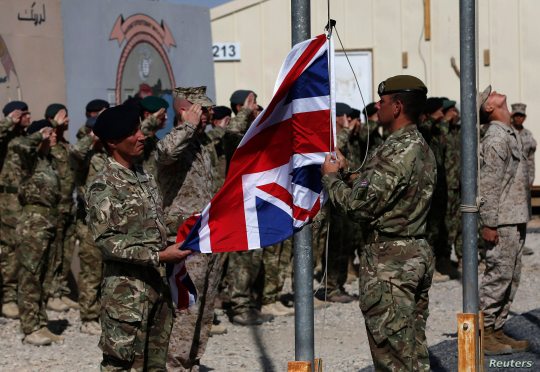
In conclusion In the face of failure, there is an impulse to move on and not ask “what led to this?” But to avoid a reckoning with our follies is to risk their repetition, or worse.
it is probably too late to salvage either the civil or military situation in Afghanistan. It almost certainly is too late to salvage it with limited in-country U.S. forces, outside U.S. airpower and intelligence assets, and with no real peace agreement or functional peace process. Limited military measures are not the answer, and neither is simply reinforcing the past processes of failure. Tragic as it may be, withdrawal may not solve anything and may well make conditions worse for millions of Afghans, but reinforcing failure is not a meaningful strategy.

I do feel strongly that both the American and British governments must establish a clear path of redemption so that those who served and the families who sacrificed loved ones know that their loss was not wasted. At the same time our civilian governments must limit missions to intelligence collection and counter-terrorism missions that will prevent the metastasis of al-Qaeda or Isis in the region should the Afghan government fall. How we balance these two is going to be very interesting to follow in the next chapter in Afghanistan’s tortured history.
I apologise for the length of this post. This has been a hard post to write because of the subject matter and the many conflicted emotions and memories I have of my time in Afghanistan. I wish I had all the answers but I suppose the beginning of wisdom would be to know how to ask the right questions. Because we didn’t ask the right questions when we went in, we ended up making a real mess of it.
There is an understandable desire to bring all our allied troops home safe and that not another life is lost there. Yet I doubt this policy of withdrawing all troops will bring peace to anyone, not to us and most of all, the Afghanis themselves. As always in war it is the native population that will bear the real cost of war, in this case women, girls, and others brutalised under Taliban rule. What lies for them if the Taliban regain power to govern the country in their image is something I care not to imagine but retain a deep foreboding of their continued suffering. Ordinary Afghanis just want a respite from war and have a chance to live in peace, but without having us foreigners or the Taliban around. It is hard to imagine that happening at all. Our desire to save our soldiers’ lives set against ordinary Afghanis being left at the mercy of the Taliban is one of those humbling and brutalising trade offs that any war can only offer.

Near the end of his famed novel, The Great Gatsby, F. Scott Fitzgerald described two of his privileged characters, Tom and Daisy, as “careless people” who “smashed up things and creatures” and then “retreated back into their money or their vast carelessness” to “let other people clean up the mess they had made.”
That description applies to America as a whole but also to we Brits and other Europeans, especially when we tire of a misguided war. Americans and we Brits are a careless people. In both Iraq and Afghanistan, we smashed up things and human beings with abandon, only to retreat into our materialism. No scratch that, returning soldiers retreated into themselves struggling with PTSD whilst the rest of our citizenry carried on with their own material struggles and their insipid culture wars. The point is we always leave others to clean up the mess in a very bloody fashion that never troubles our conscience.
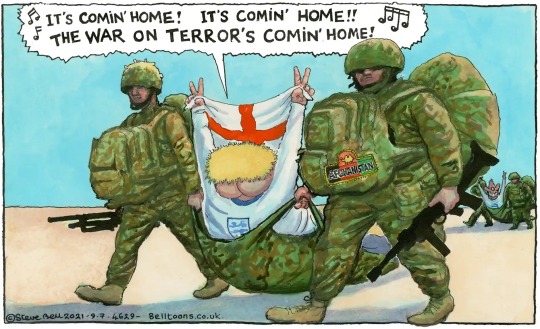
Count on us, probably sooner rather than later, doing precisely the same thing in Afghanistan. Again.
Thanks for your question
#question#ask#afghanistan#war#terrorism#warfare#history#america#britain#taliban#pakistan#china#south asia#security#intelligence#europe#un#isaf#nation building#politics#power#military#personal
163 notes
·
View notes